Maximizing Sunlight and Avoid Overheating
VerifiedAdded on 2023/01/03
|28
|7410
|97
AI Summary
This report explores the use of passive design strategies to maximize sunlight and avoid overheating in buildings. It covers topics such as heat gain sources, heat transfer mechanisms, internal casual gains, and solar gains. The aim is to improve thermal performance and reduce energy consumption.
Contribute Materials
Your contribution can guide someone’s learning journey. Share your
documents today.
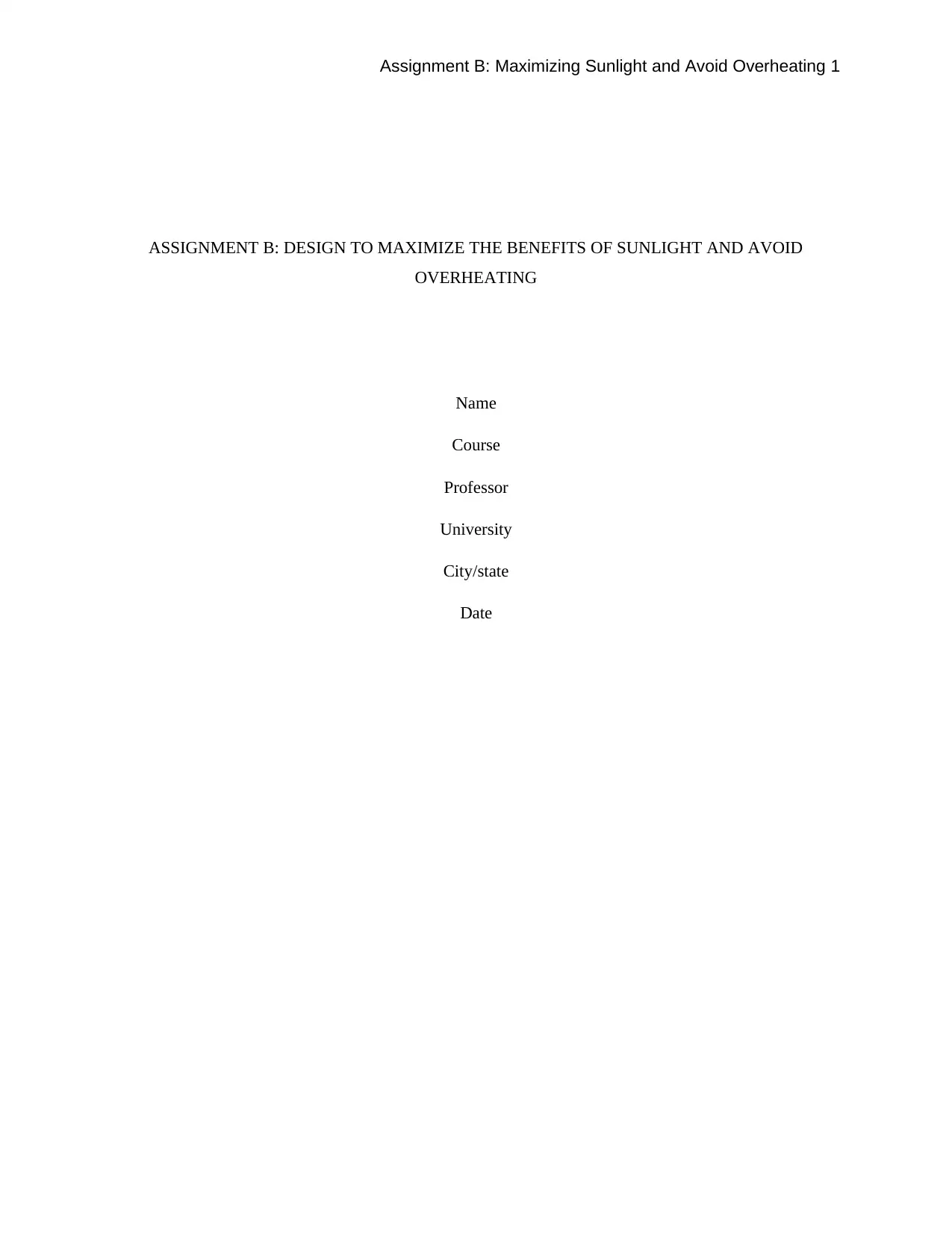
Assignment B: Maximizing Sunlight and Avoid Overheating 1
ASSIGNMENT B: DESIGN TO MAXIMIZE THE BENEFITS OF SUNLIGHT AND AVOID
OVERHEATING
Name
Course
Professor
University
City/state
Date
ASSIGNMENT B: DESIGN TO MAXIMIZE THE BENEFITS OF SUNLIGHT AND AVOID
OVERHEATING
Name
Course
Professor
University
City/state
Date
Secure Best Marks with AI Grader
Need help grading? Try our AI Grader for instant feedback on your assignments.
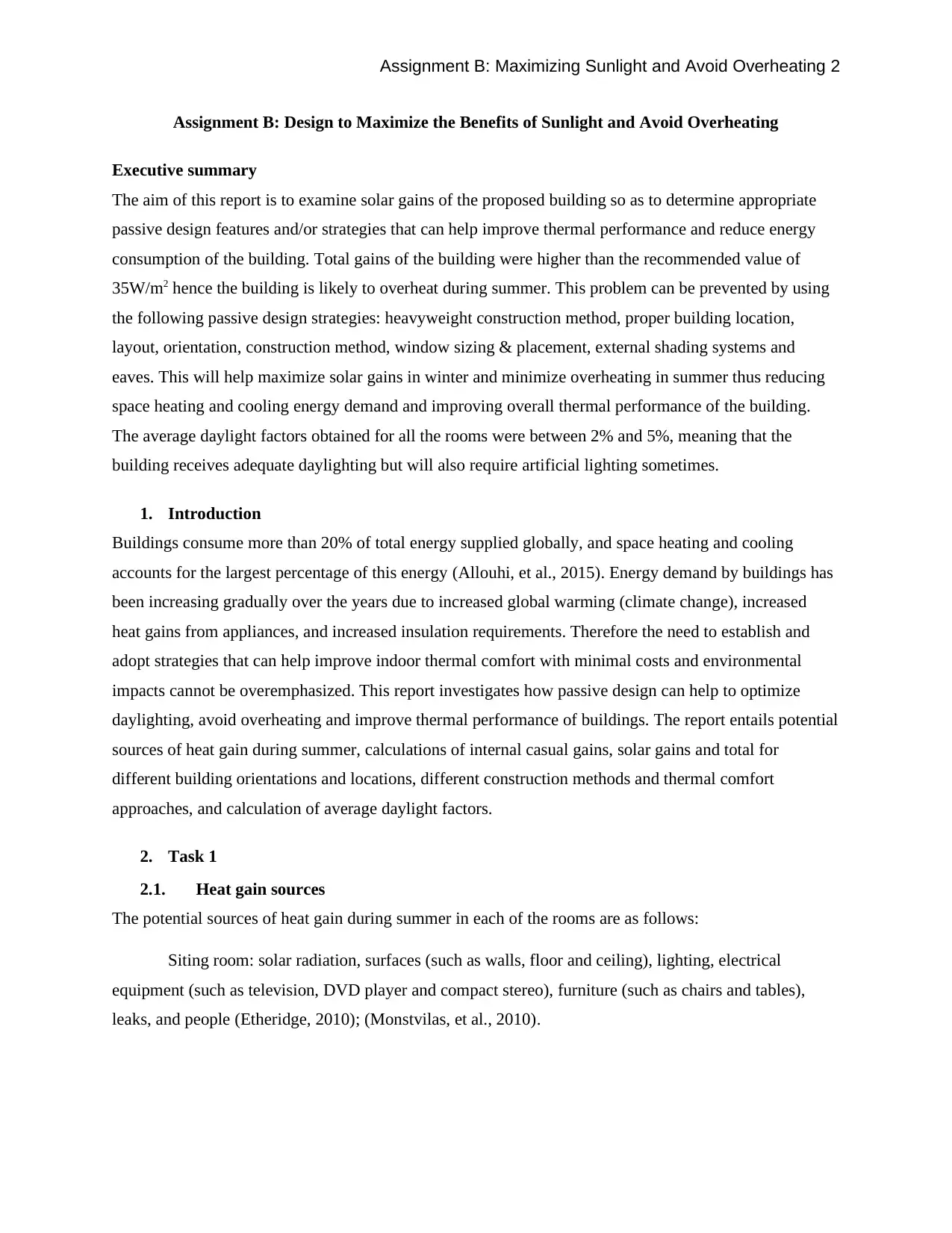
Assignment B: Maximizing Sunlight and Avoid Overheating 2
Assignment B: Design to Maximize the Benefits of Sunlight and Avoid Overheating
Executive summary
The aim of this report is to examine solar gains of the proposed building so as to determine appropriate
passive design features and/or strategies that can help improve thermal performance and reduce energy
consumption of the building. Total gains of the building were higher than the recommended value of
35W/m2 hence the building is likely to overheat during summer. This problem can be prevented by using
the following passive design strategies: heavyweight construction method, proper building location,
layout, orientation, construction method, window sizing & placement, external shading systems and
eaves. This will help maximize solar gains in winter and minimize overheating in summer thus reducing
space heating and cooling energy demand and improving overall thermal performance of the building.
The average daylight factors obtained for all the rooms were between 2% and 5%, meaning that the
building receives adequate daylighting but will also require artificial lighting sometimes.
1. Introduction
Buildings consume more than 20% of total energy supplied globally, and space heating and cooling
accounts for the largest percentage of this energy (Allouhi, et al., 2015). Energy demand by buildings has
been increasing gradually over the years due to increased global warming (climate change), increased
heat gains from appliances, and increased insulation requirements. Therefore the need to establish and
adopt strategies that can help improve indoor thermal comfort with minimal costs and environmental
impacts cannot be overemphasized. This report investigates how passive design can help to optimize
daylighting, avoid overheating and improve thermal performance of buildings. The report entails potential
sources of heat gain during summer, calculations of internal casual gains, solar gains and total for
different building orientations and locations, different construction methods and thermal comfort
approaches, and calculation of average daylight factors.
2. Task 1
2.1. Heat gain sources
The potential sources of heat gain during summer in each of the rooms are as follows:
Siting room: solar radiation, surfaces (such as walls, floor and ceiling), lighting, electrical
equipment (such as television, DVD player and compact stereo), furniture (such as chairs and tables),
leaks, and people (Etheridge, 2010); (Monstvilas, et al., 2010).
Assignment B: Design to Maximize the Benefits of Sunlight and Avoid Overheating
Executive summary
The aim of this report is to examine solar gains of the proposed building so as to determine appropriate
passive design features and/or strategies that can help improve thermal performance and reduce energy
consumption of the building. Total gains of the building were higher than the recommended value of
35W/m2 hence the building is likely to overheat during summer. This problem can be prevented by using
the following passive design strategies: heavyweight construction method, proper building location,
layout, orientation, construction method, window sizing & placement, external shading systems and
eaves. This will help maximize solar gains in winter and minimize overheating in summer thus reducing
space heating and cooling energy demand and improving overall thermal performance of the building.
The average daylight factors obtained for all the rooms were between 2% and 5%, meaning that the
building receives adequate daylighting but will also require artificial lighting sometimes.
1. Introduction
Buildings consume more than 20% of total energy supplied globally, and space heating and cooling
accounts for the largest percentage of this energy (Allouhi, et al., 2015). Energy demand by buildings has
been increasing gradually over the years due to increased global warming (climate change), increased
heat gains from appliances, and increased insulation requirements. Therefore the need to establish and
adopt strategies that can help improve indoor thermal comfort with minimal costs and environmental
impacts cannot be overemphasized. This report investigates how passive design can help to optimize
daylighting, avoid overheating and improve thermal performance of buildings. The report entails potential
sources of heat gain during summer, calculations of internal casual gains, solar gains and total for
different building orientations and locations, different construction methods and thermal comfort
approaches, and calculation of average daylight factors.
2. Task 1
2.1. Heat gain sources
The potential sources of heat gain during summer in each of the rooms are as follows:
Siting room: solar radiation, surfaces (such as walls, floor and ceiling), lighting, electrical
equipment (such as television, DVD player and compact stereo), furniture (such as chairs and tables),
leaks, and people (Etheridge, 2010); (Monstvilas, et al., 2010).
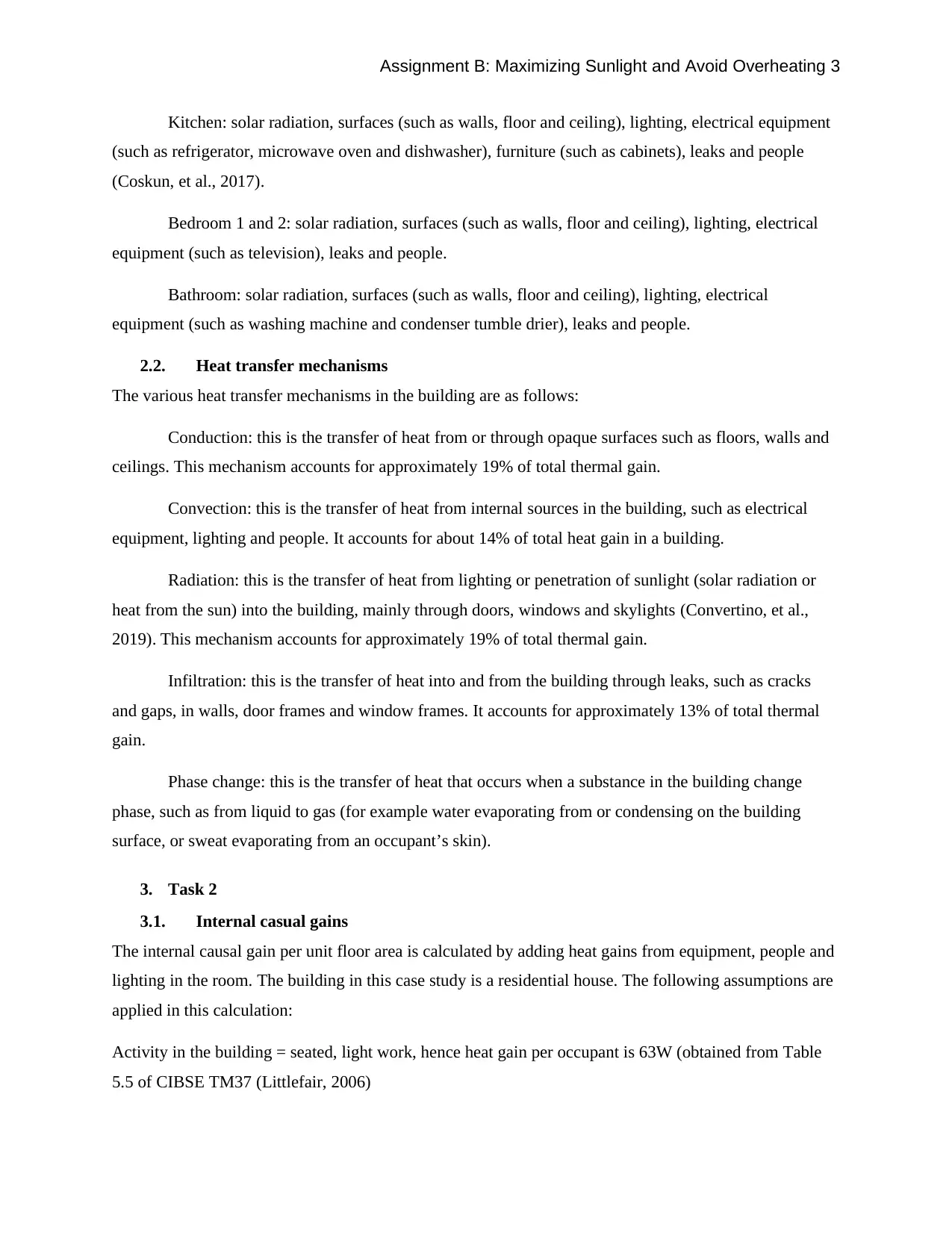
Assignment B: Maximizing Sunlight and Avoid Overheating 3
Kitchen: solar radiation, surfaces (such as walls, floor and ceiling), lighting, electrical equipment
(such as refrigerator, microwave oven and dishwasher), furniture (such as cabinets), leaks and people
(Coskun, et al., 2017).
Bedroom 1 and 2: solar radiation, surfaces (such as walls, floor and ceiling), lighting, electrical
equipment (such as television), leaks and people.
Bathroom: solar radiation, surfaces (such as walls, floor and ceiling), lighting, electrical
equipment (such as washing machine and condenser tumble drier), leaks and people.
2.2. Heat transfer mechanisms
The various heat transfer mechanisms in the building are as follows:
Conduction: this is the transfer of heat from or through opaque surfaces such as floors, walls and
ceilings. This mechanism accounts for approximately 19% of total thermal gain.
Convection: this is the transfer of heat from internal sources in the building, such as electrical
equipment, lighting and people. It accounts for about 14% of total heat gain in a building.
Radiation: this is the transfer of heat from lighting or penetration of sunlight (solar radiation or
heat from the sun) into the building, mainly through doors, windows and skylights (Convertino, et al.,
2019). This mechanism accounts for approximately 19% of total thermal gain.
Infiltration: this is the transfer of heat into and from the building through leaks, such as cracks
and gaps, in walls, door frames and window frames. It accounts for approximately 13% of total thermal
gain.
Phase change: this is the transfer of heat that occurs when a substance in the building change
phase, such as from liquid to gas (for example water evaporating from or condensing on the building
surface, or sweat evaporating from an occupant’s skin).
3. Task 2
3.1. Internal casual gains
The internal causal gain per unit floor area is calculated by adding heat gains from equipment, people and
lighting in the room. The building in this case study is a residential house. The following assumptions are
applied in this calculation:
Activity in the building = seated, light work, hence heat gain per occupant is 63W (obtained from Table
5.5 of CIBSE TM37 (Littlefair, 2006)
Kitchen: solar radiation, surfaces (such as walls, floor and ceiling), lighting, electrical equipment
(such as refrigerator, microwave oven and dishwasher), furniture (such as cabinets), leaks and people
(Coskun, et al., 2017).
Bedroom 1 and 2: solar radiation, surfaces (such as walls, floor and ceiling), lighting, electrical
equipment (such as television), leaks and people.
Bathroom: solar radiation, surfaces (such as walls, floor and ceiling), lighting, electrical
equipment (such as washing machine and condenser tumble drier), leaks and people.
2.2. Heat transfer mechanisms
The various heat transfer mechanisms in the building are as follows:
Conduction: this is the transfer of heat from or through opaque surfaces such as floors, walls and
ceilings. This mechanism accounts for approximately 19% of total thermal gain.
Convection: this is the transfer of heat from internal sources in the building, such as electrical
equipment, lighting and people. It accounts for about 14% of total heat gain in a building.
Radiation: this is the transfer of heat from lighting or penetration of sunlight (solar radiation or
heat from the sun) into the building, mainly through doors, windows and skylights (Convertino, et al.,
2019). This mechanism accounts for approximately 19% of total thermal gain.
Infiltration: this is the transfer of heat into and from the building through leaks, such as cracks
and gaps, in walls, door frames and window frames. It accounts for approximately 13% of total thermal
gain.
Phase change: this is the transfer of heat that occurs when a substance in the building change
phase, such as from liquid to gas (for example water evaporating from or condensing on the building
surface, or sweat evaporating from an occupant’s skin).
3. Task 2
3.1. Internal casual gains
The internal causal gain per unit floor area is calculated by adding heat gains from equipment, people and
lighting in the room. The building in this case study is a residential house. The following assumptions are
applied in this calculation:
Activity in the building = seated, light work, hence heat gain per occupant is 63W (obtained from Table
5.5 of CIBSE TM37 (Littlefair, 2006)
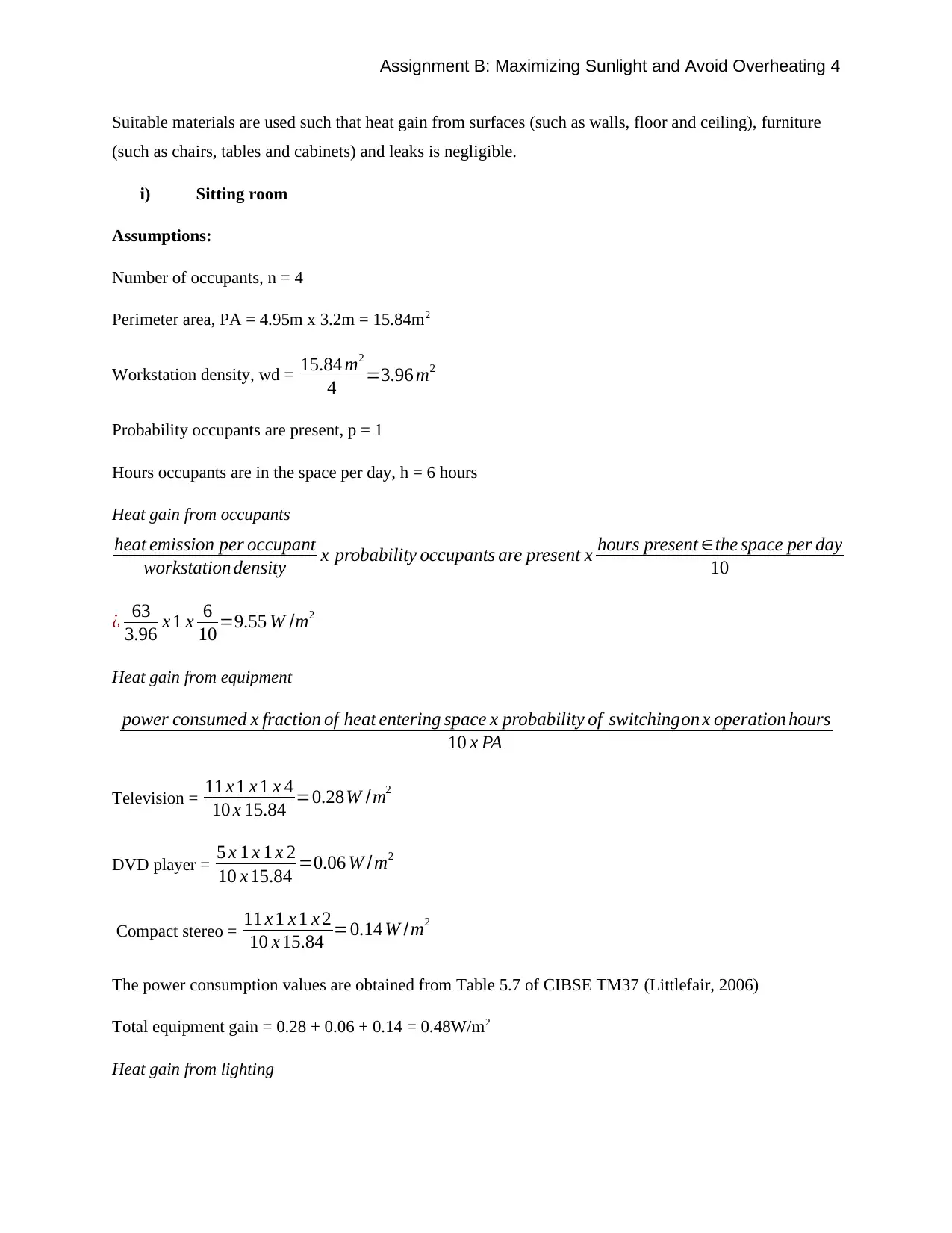
Assignment B: Maximizing Sunlight and Avoid Overheating 4
Suitable materials are used such that heat gain from surfaces (such as walls, floor and ceiling), furniture
(such as chairs, tables and cabinets) and leaks is negligible.
i) Sitting room
Assumptions:
Number of occupants, n = 4
Perimeter area, PA = 4.95m x 3.2m = 15.84m2
Workstation density, wd = 15.84 m2
4 =3.96 m2
Probability occupants are present, p = 1
Hours occupants are in the space per day, h = 6 hours
Heat gain from occupants
heat emission per occupant
workstation density x probability occupants are present x hours present ∈the space per day
10
¿ 63
3.96 x 1 x 6
10 =9.55 W /m2
Heat gain from equipment
power consumed x fraction of heat entering space x probability of switchingon x operation hours
10 x PA
Television = 11 x 1 x 1 x 4
10 x 15.84 =0.28W /m2
DVD player = 5 x 1 x 1 x 2
10 x 15.84 =0.06 W /m2
Compact stereo = 11 x 1 x 1 x 2
10 x 15.84 =0.14 W /m2
The power consumption values are obtained from Table 5.7 of CIBSE TM37 (Littlefair, 2006)
Total equipment gain = 0.28 + 0.06 + 0.14 = 0.48W/m2
Heat gain from lighting
Suitable materials are used such that heat gain from surfaces (such as walls, floor and ceiling), furniture
(such as chairs, tables and cabinets) and leaks is negligible.
i) Sitting room
Assumptions:
Number of occupants, n = 4
Perimeter area, PA = 4.95m x 3.2m = 15.84m2
Workstation density, wd = 15.84 m2
4 =3.96 m2
Probability occupants are present, p = 1
Hours occupants are in the space per day, h = 6 hours
Heat gain from occupants
heat emission per occupant
workstation density x probability occupants are present x hours present ∈the space per day
10
¿ 63
3.96 x 1 x 6
10 =9.55 W /m2
Heat gain from equipment
power consumed x fraction of heat entering space x probability of switchingon x operation hours
10 x PA
Television = 11 x 1 x 1 x 4
10 x 15.84 =0.28W /m2
DVD player = 5 x 1 x 1 x 2
10 x 15.84 =0.06 W /m2
Compact stereo = 11 x 1 x 1 x 2
10 x 15.84 =0.14 W /m2
The power consumption values are obtained from Table 5.7 of CIBSE TM37 (Littlefair, 2006)
Total equipment gain = 0.28 + 0.06 + 0.14 = 0.48W/m2
Heat gain from lighting
Secure Best Marks with AI Grader
Need help grading? Try our AI Grader for instant feedback on your assignments.
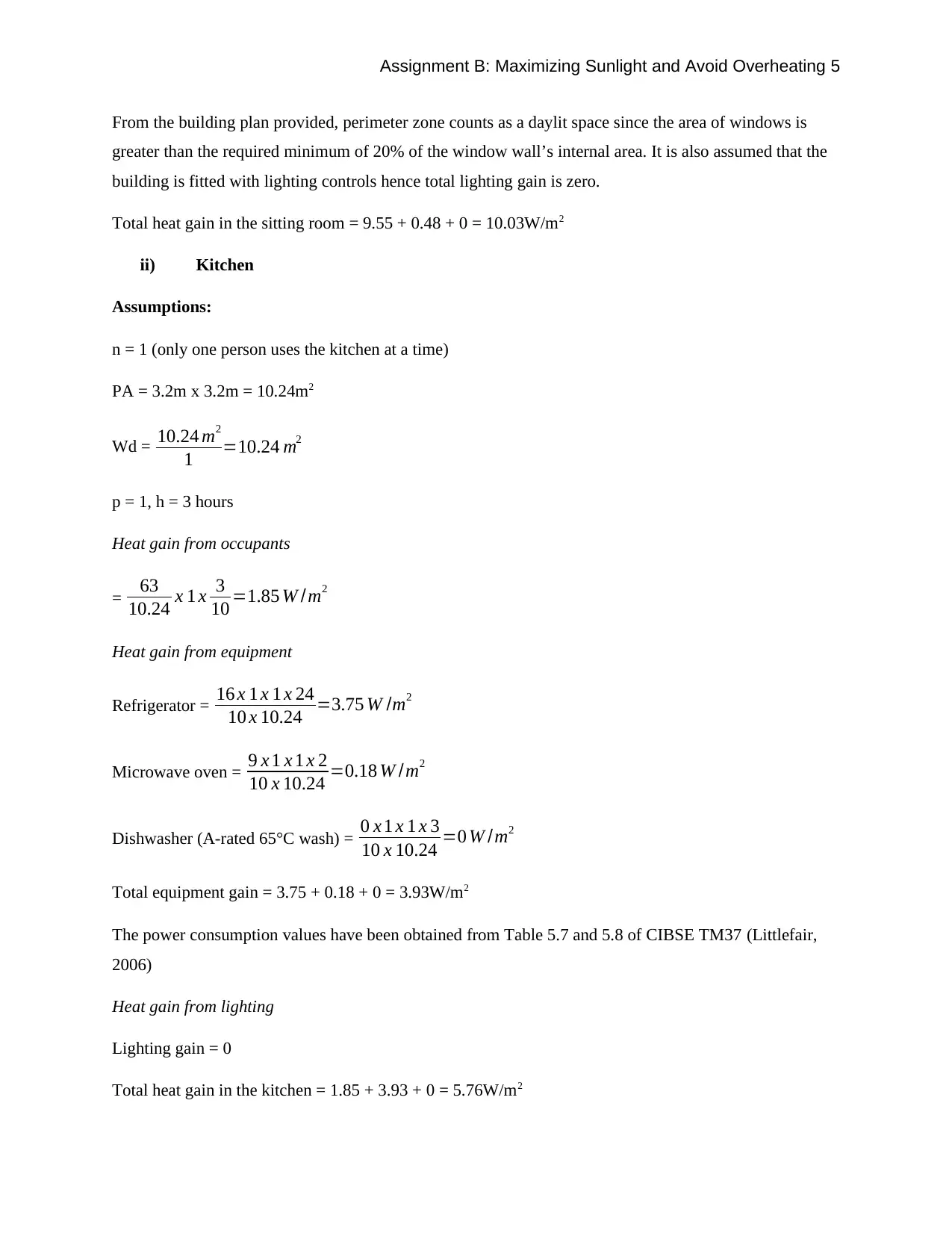
Assignment B: Maximizing Sunlight and Avoid Overheating 5
From the building plan provided, perimeter zone counts as a daylit space since the area of windows is
greater than the required minimum of 20% of the window wall’s internal area. It is also assumed that the
building is fitted with lighting controls hence total lighting gain is zero.
Total heat gain in the sitting room = 9.55 + 0.48 + 0 = 10.03W/m2
ii) Kitchen
Assumptions:
n = 1 (only one person uses the kitchen at a time)
PA = 3.2m x 3.2m = 10.24m2
Wd = 10.24 m2
1 =10.24 m2
p = 1, h = 3 hours
Heat gain from occupants
= 63
10.24 x 1 x 3
10 =1.85 W /m2
Heat gain from equipment
Refrigerator = 16 x 1 x 1 x 24
10 x 10.24 =3.75 W /m2
Microwave oven = 9 x 1 x 1 x 2
10 x 10.24 =0.18 W /m2
Dishwasher (A-rated 65°C wash) = 0 x 1 x 1 x 3
10 x 10.24 =0 W /m2
Total equipment gain = 3.75 + 0.18 + 0 = 3.93W/m2
The power consumption values have been obtained from Table 5.7 and 5.8 of CIBSE TM37 (Littlefair,
2006)
Heat gain from lighting
Lighting gain = 0
Total heat gain in the kitchen = 1.85 + 3.93 + 0 = 5.76W/m2
From the building plan provided, perimeter zone counts as a daylit space since the area of windows is
greater than the required minimum of 20% of the window wall’s internal area. It is also assumed that the
building is fitted with lighting controls hence total lighting gain is zero.
Total heat gain in the sitting room = 9.55 + 0.48 + 0 = 10.03W/m2
ii) Kitchen
Assumptions:
n = 1 (only one person uses the kitchen at a time)
PA = 3.2m x 3.2m = 10.24m2
Wd = 10.24 m2
1 =10.24 m2
p = 1, h = 3 hours
Heat gain from occupants
= 63
10.24 x 1 x 3
10 =1.85 W /m2
Heat gain from equipment
Refrigerator = 16 x 1 x 1 x 24
10 x 10.24 =3.75 W /m2
Microwave oven = 9 x 1 x 1 x 2
10 x 10.24 =0.18 W /m2
Dishwasher (A-rated 65°C wash) = 0 x 1 x 1 x 3
10 x 10.24 =0 W /m2
Total equipment gain = 3.75 + 0.18 + 0 = 3.93W/m2
The power consumption values have been obtained from Table 5.7 and 5.8 of CIBSE TM37 (Littlefair,
2006)
Heat gain from lighting
Lighting gain = 0
Total heat gain in the kitchen = 1.85 + 3.93 + 0 = 5.76W/m2
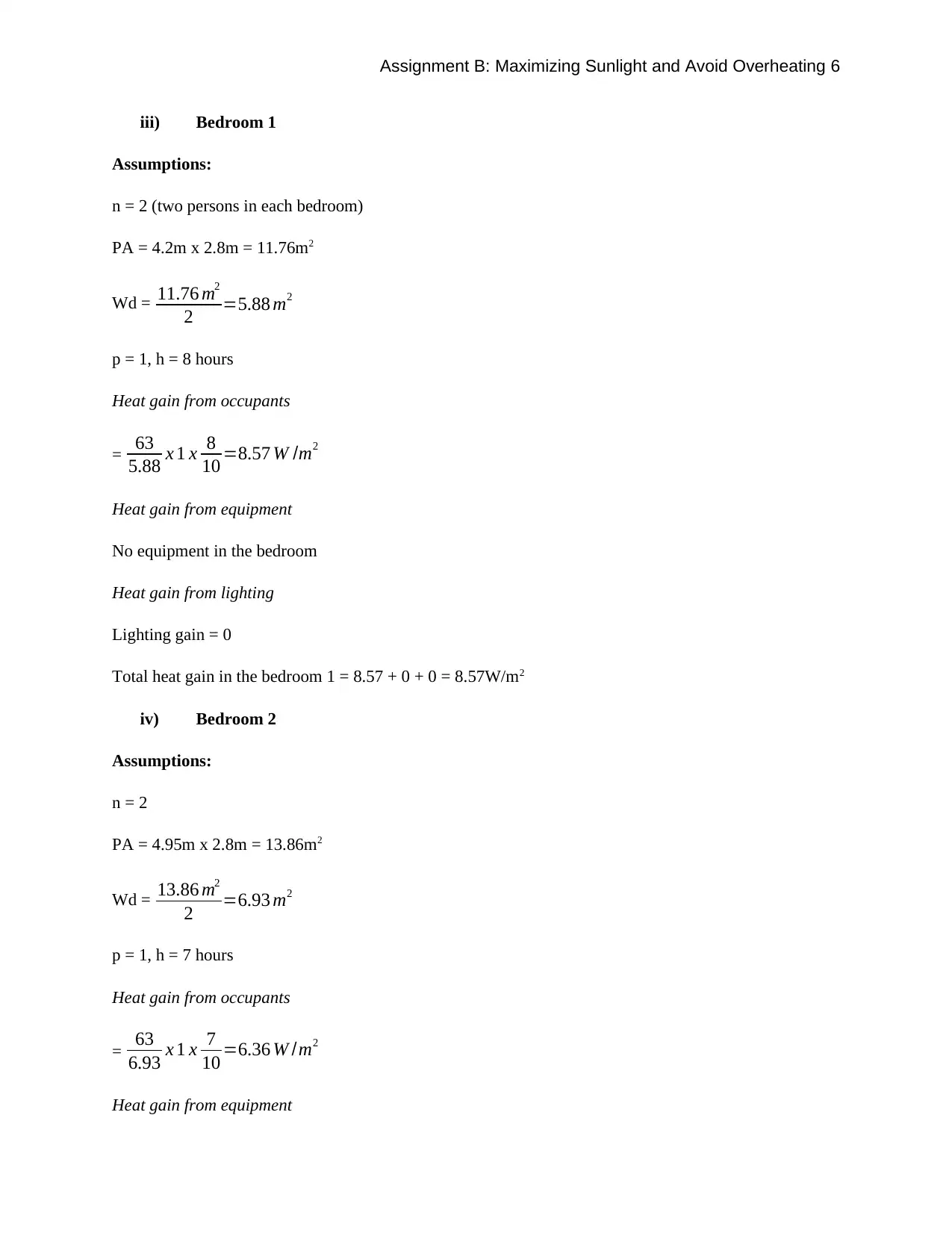
Assignment B: Maximizing Sunlight and Avoid Overheating 6
iii) Bedroom 1
Assumptions:
n = 2 (two persons in each bedroom)
PA = 4.2m x 2.8m = 11.76m2
Wd = 11.76 m2
2 =5.88 m2
p = 1, h = 8 hours
Heat gain from occupants
= 63
5.88 x 1 x 8
10 =8.57 W /m2
Heat gain from equipment
No equipment in the bedroom
Heat gain from lighting
Lighting gain = 0
Total heat gain in the bedroom 1 = 8.57 + 0 + 0 = 8.57W/m2
iv) Bedroom 2
Assumptions:
n = 2
PA = 4.95m x 2.8m = 13.86m2
Wd = 13.86 m2
2 =6.93 m2
p = 1, h = 7 hours
Heat gain from occupants
= 63
6.93 x 1 x 7
10 =6.36 W /m2
Heat gain from equipment
iii) Bedroom 1
Assumptions:
n = 2 (two persons in each bedroom)
PA = 4.2m x 2.8m = 11.76m2
Wd = 11.76 m2
2 =5.88 m2
p = 1, h = 8 hours
Heat gain from occupants
= 63
5.88 x 1 x 8
10 =8.57 W /m2
Heat gain from equipment
No equipment in the bedroom
Heat gain from lighting
Lighting gain = 0
Total heat gain in the bedroom 1 = 8.57 + 0 + 0 = 8.57W/m2
iv) Bedroom 2
Assumptions:
n = 2
PA = 4.95m x 2.8m = 13.86m2
Wd = 13.86 m2
2 =6.93 m2
p = 1, h = 7 hours
Heat gain from occupants
= 63
6.93 x 1 x 7
10 =6.36 W /m2
Heat gain from equipment
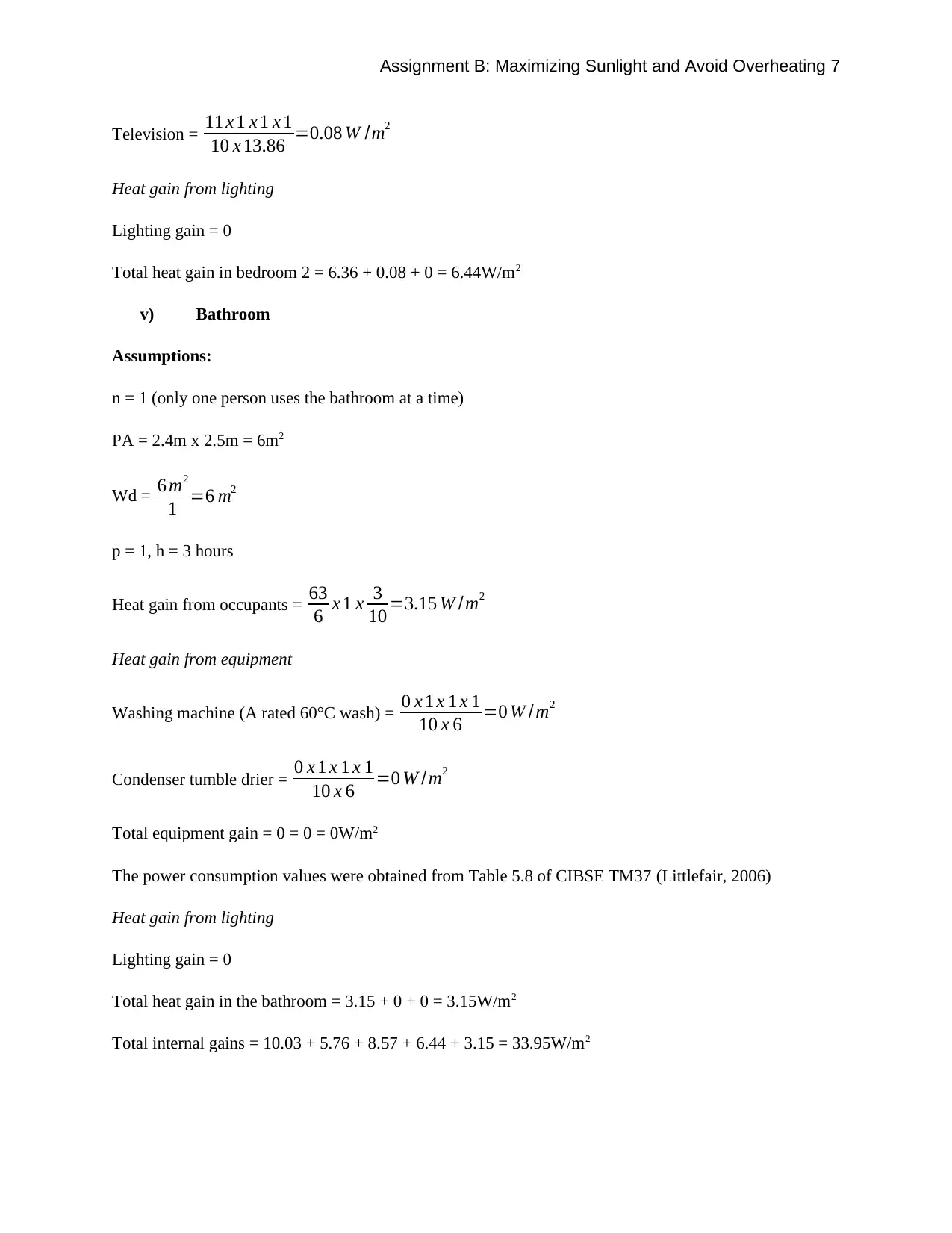
Assignment B: Maximizing Sunlight and Avoid Overheating 7
Television = 11 x 1 x 1 x 1
10 x 13.86 =0.08 W /m2
Heat gain from lighting
Lighting gain = 0
Total heat gain in bedroom 2 = 6.36 + 0.08 + 0 = 6.44W/m2
v) Bathroom
Assumptions:
n = 1 (only one person uses the bathroom at a time)
PA = 2.4m x 2.5m = 6m2
Wd = 6 m2
1 =6 m2
p = 1, h = 3 hours
Heat gain from occupants = 63
6 x 1 x 3
10 =3.15 W /m2
Heat gain from equipment
Washing machine (A rated 60°C wash) = 0 x 1 x 1 x 1
10 x 6 =0 W /m2
Condenser tumble drier = 0 x 1 x 1 x 1
10 x 6 =0 W /m2
Total equipment gain = 0 = 0 = 0W/m2
The power consumption values were obtained from Table 5.8 of CIBSE TM37 (Littlefair, 2006)
Heat gain from lighting
Lighting gain = 0
Total heat gain in the bathroom = 3.15 + 0 + 0 = 3.15W/m2
Total internal gains = 10.03 + 5.76 + 8.57 + 6.44 + 3.15 = 33.95W/m2
Television = 11 x 1 x 1 x 1
10 x 13.86 =0.08 W /m2
Heat gain from lighting
Lighting gain = 0
Total heat gain in bedroom 2 = 6.36 + 0.08 + 0 = 6.44W/m2
v) Bathroom
Assumptions:
n = 1 (only one person uses the bathroom at a time)
PA = 2.4m x 2.5m = 6m2
Wd = 6 m2
1 =6 m2
p = 1, h = 3 hours
Heat gain from occupants = 63
6 x 1 x 3
10 =3.15 W /m2
Heat gain from equipment
Washing machine (A rated 60°C wash) = 0 x 1 x 1 x 1
10 x 6 =0 W /m2
Condenser tumble drier = 0 x 1 x 1 x 1
10 x 6 =0 W /m2
Total equipment gain = 0 = 0 = 0W/m2
The power consumption values were obtained from Table 5.8 of CIBSE TM37 (Littlefair, 2006)
Heat gain from lighting
Lighting gain = 0
Total heat gain in the bathroom = 3.15 + 0 + 0 = 3.15W/m2
Total internal gains = 10.03 + 5.76 + 8.57 + 6.44 + 3.15 = 33.95W/m2
Paraphrase This Document
Need a fresh take? Get an instant paraphrase of this document with our AI Paraphraser
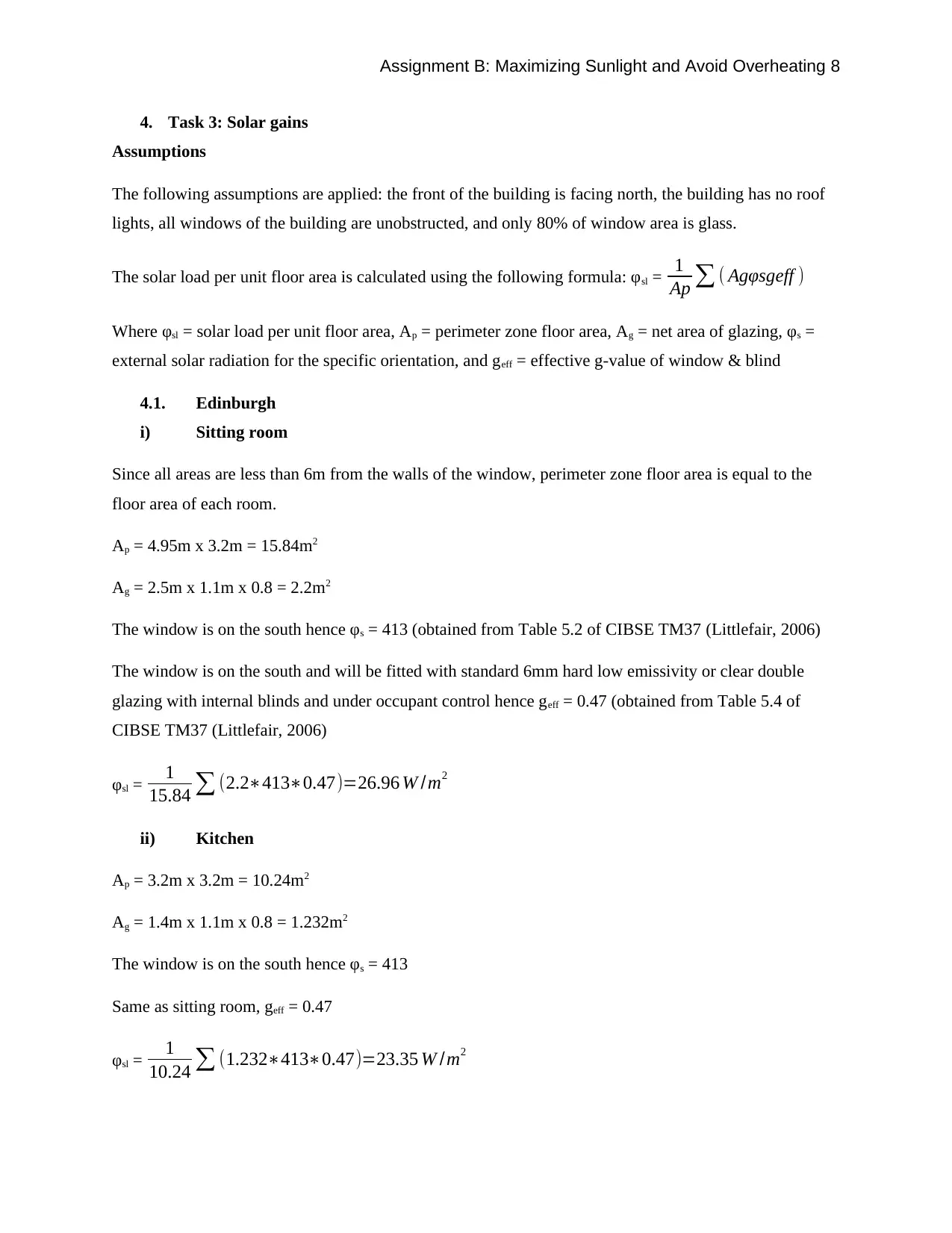
Assignment B: Maximizing Sunlight and Avoid Overheating 8
4. Task 3: Solar gains
Assumptions
The following assumptions are applied: the front of the building is facing north, the building has no roof
lights, all windows of the building are unobstructed, and only 80% of window area is glass.
The solar load per unit floor area is calculated using the following formula: φsl = 1
Ap ∑ ( Agφsgeff )
Where φsl = solar load per unit floor area, Ap = perimeter zone floor area, Ag = net area of glazing, φs =
external solar radiation for the specific orientation, and geff = effective g-value of window & blind
4.1. Edinburgh
i) Sitting room
Since all areas are less than 6m from the walls of the window, perimeter zone floor area is equal to the
floor area of each room.
Ap = 4.95m x 3.2m = 15.84m2
Ag = 2.5m x 1.1m x 0.8 = 2.2m2
The window is on the south hence φs = 413 (obtained from Table 5.2 of CIBSE TM37 (Littlefair, 2006)
The window is on the south and will be fitted with standard 6mm hard low emissivity or clear double
glazing with internal blinds and under occupant control hence geff = 0.47 (obtained from Table 5.4 of
CIBSE TM37 (Littlefair, 2006)
φsl = 1
15.84 ∑ (2.2∗413∗0.47)=26.96 W /m2
ii) Kitchen
Ap = 3.2m x 3.2m = 10.24m2
Ag = 1.4m x 1.1m x 0.8 = 1.232m2
The window is on the south hence φs = 413
Same as sitting room, geff = 0.47
φsl = 1
10.24 ∑ (1.232∗413∗0.47)=23.35 W /m2
4. Task 3: Solar gains
Assumptions
The following assumptions are applied: the front of the building is facing north, the building has no roof
lights, all windows of the building are unobstructed, and only 80% of window area is glass.
The solar load per unit floor area is calculated using the following formula: φsl = 1
Ap ∑ ( Agφsgeff )
Where φsl = solar load per unit floor area, Ap = perimeter zone floor area, Ag = net area of glazing, φs =
external solar radiation for the specific orientation, and geff = effective g-value of window & blind
4.1. Edinburgh
i) Sitting room
Since all areas are less than 6m from the walls of the window, perimeter zone floor area is equal to the
floor area of each room.
Ap = 4.95m x 3.2m = 15.84m2
Ag = 2.5m x 1.1m x 0.8 = 2.2m2
The window is on the south hence φs = 413 (obtained from Table 5.2 of CIBSE TM37 (Littlefair, 2006)
The window is on the south and will be fitted with standard 6mm hard low emissivity or clear double
glazing with internal blinds and under occupant control hence geff = 0.47 (obtained from Table 5.4 of
CIBSE TM37 (Littlefair, 2006)
φsl = 1
15.84 ∑ (2.2∗413∗0.47)=26.96 W /m2
ii) Kitchen
Ap = 3.2m x 3.2m = 10.24m2
Ag = 1.4m x 1.1m x 0.8 = 1.232m2
The window is on the south hence φs = 413
Same as sitting room, geff = 0.47
φsl = 1
10.24 ∑ (1.232∗413∗0.47)=23.35 W /m2
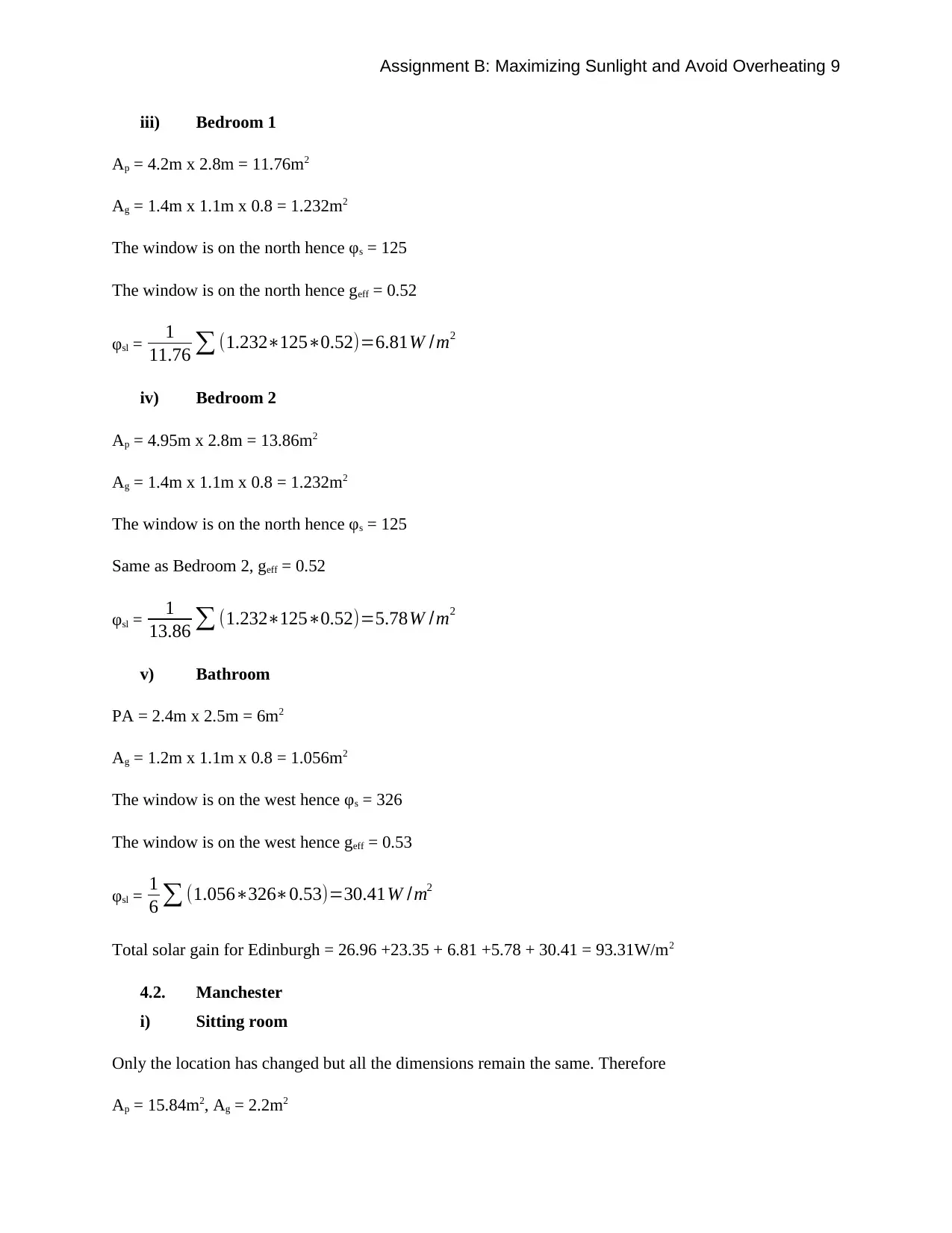
Assignment B: Maximizing Sunlight and Avoid Overheating 9
iii) Bedroom 1
Ap = 4.2m x 2.8m = 11.76m2
Ag = 1.4m x 1.1m x 0.8 = 1.232m2
The window is on the north hence φs = 125
The window is on the north hence geff = 0.52
φsl = 1
11.76 ∑ (1.232∗125∗0.52)=6.81W /m2
iv) Bedroom 2
Ap = 4.95m x 2.8m = 13.86m2
Ag = 1.4m x 1.1m x 0.8 = 1.232m2
The window is on the north hence φs = 125
Same as Bedroom 2, geff = 0.52
φsl = 1
13.86 ∑ (1.232∗125∗0.52)=5.78W /m2
v) Bathroom
PA = 2.4m x 2.5m = 6m2
Ag = 1.2m x 1.1m x 0.8 = 1.056m2
The window is on the west hence φs = 326
The window is on the west hence geff = 0.53
φsl = 1
6 ∑ (1.056∗326∗0.53)=30.41W /m2
Total solar gain for Edinburgh = 26.96 +23.35 + 6.81 +5.78 + 30.41 = 93.31W/m2
4.2. Manchester
i) Sitting room
Only the location has changed but all the dimensions remain the same. Therefore
Ap = 15.84m2, Ag = 2.2m2
iii) Bedroom 1
Ap = 4.2m x 2.8m = 11.76m2
Ag = 1.4m x 1.1m x 0.8 = 1.232m2
The window is on the north hence φs = 125
The window is on the north hence geff = 0.52
φsl = 1
11.76 ∑ (1.232∗125∗0.52)=6.81W /m2
iv) Bedroom 2
Ap = 4.95m x 2.8m = 13.86m2
Ag = 1.4m x 1.1m x 0.8 = 1.232m2
The window is on the north hence φs = 125
Same as Bedroom 2, geff = 0.52
φsl = 1
13.86 ∑ (1.232∗125∗0.52)=5.78W /m2
v) Bathroom
PA = 2.4m x 2.5m = 6m2
Ag = 1.2m x 1.1m x 0.8 = 1.056m2
The window is on the west hence φs = 326
The window is on the west hence geff = 0.53
φsl = 1
6 ∑ (1.056∗326∗0.53)=30.41W /m2
Total solar gain for Edinburgh = 26.96 +23.35 + 6.81 +5.78 + 30.41 = 93.31W/m2
4.2. Manchester
i) Sitting room
Only the location has changed but all the dimensions remain the same. Therefore
Ap = 15.84m2, Ag = 2.2m2
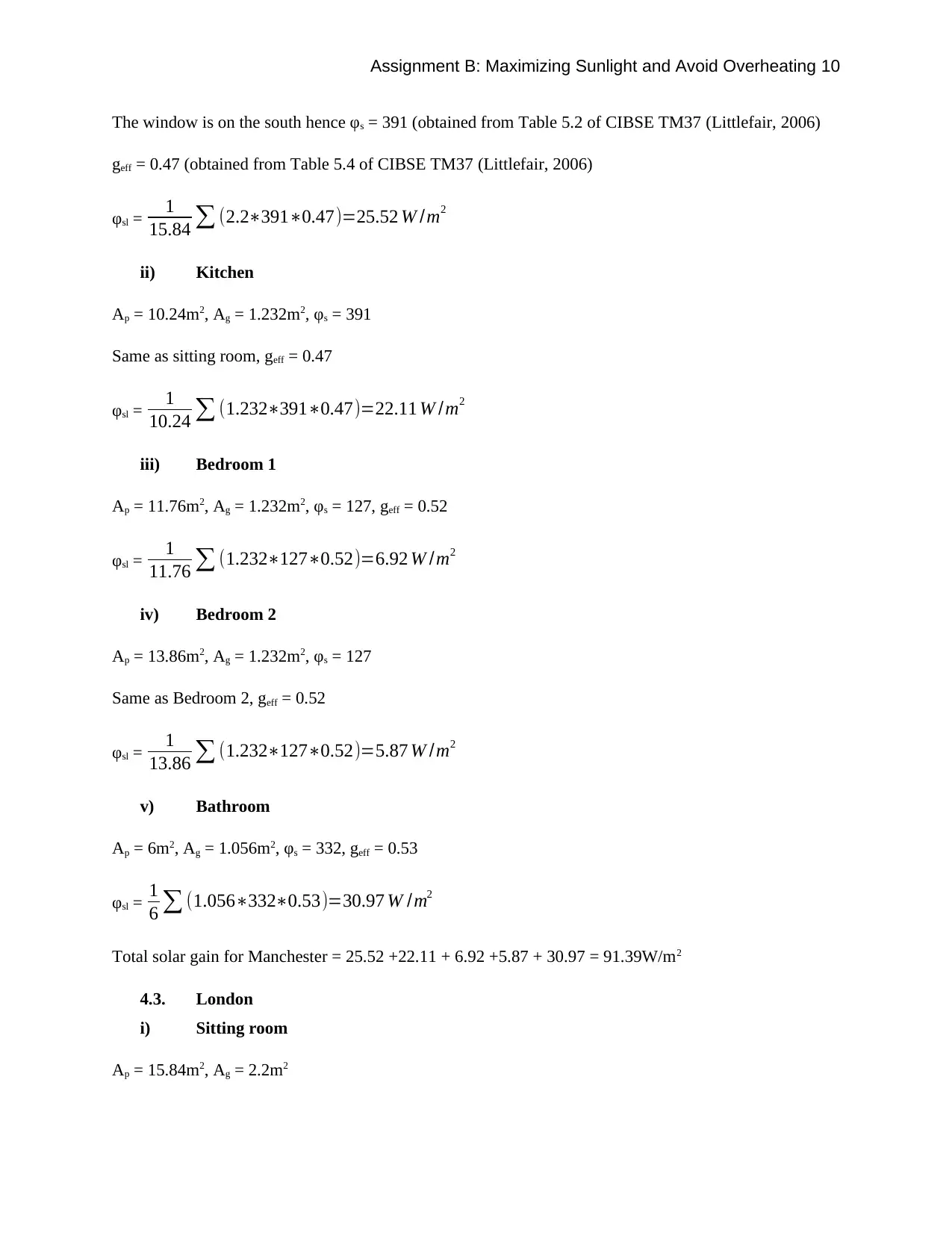
Assignment B: Maximizing Sunlight and Avoid Overheating 10
The window is on the south hence φs = 391 (obtained from Table 5.2 of CIBSE TM37 (Littlefair, 2006)
geff = 0.47 (obtained from Table 5.4 of CIBSE TM37 (Littlefair, 2006)
φsl = 1
15.84 ∑ (2.2∗391∗0.47)=25.52 W /m2
ii) Kitchen
Ap = 10.24m2, Ag = 1.232m2, φs = 391
Same as sitting room, geff = 0.47
φsl = 1
10.24 ∑ (1.232∗391∗0.47)=22.11 W /m2
iii) Bedroom 1
Ap = 11.76m2, Ag = 1.232m2, φs = 127, geff = 0.52
φsl = 1
11.76 ∑ (1.232∗127∗0.52)=6.92 W /m2
iv) Bedroom 2
Ap = 13.86m2, Ag = 1.232m2, φs = 127
Same as Bedroom 2, geff = 0.52
φsl = 1
13.86 ∑ (1.232∗127∗0.52)=5.87 W /m2
v) Bathroom
Ap = 6m2, Ag = 1.056m2, φs = 332, geff = 0.53
φsl = 1
6 ∑ (1.056∗332∗0.53)=30.97 W /m2
Total solar gain for Manchester = 25.52 +22.11 + 6.92 +5.87 + 30.97 = 91.39W/m2
4.3. London
i) Sitting room
Ap = 15.84m2, Ag = 2.2m2
The window is on the south hence φs = 391 (obtained from Table 5.2 of CIBSE TM37 (Littlefair, 2006)
geff = 0.47 (obtained from Table 5.4 of CIBSE TM37 (Littlefair, 2006)
φsl = 1
15.84 ∑ (2.2∗391∗0.47)=25.52 W /m2
ii) Kitchen
Ap = 10.24m2, Ag = 1.232m2, φs = 391
Same as sitting room, geff = 0.47
φsl = 1
10.24 ∑ (1.232∗391∗0.47)=22.11 W /m2
iii) Bedroom 1
Ap = 11.76m2, Ag = 1.232m2, φs = 127, geff = 0.52
φsl = 1
11.76 ∑ (1.232∗127∗0.52)=6.92 W /m2
iv) Bedroom 2
Ap = 13.86m2, Ag = 1.232m2, φs = 127
Same as Bedroom 2, geff = 0.52
φsl = 1
13.86 ∑ (1.232∗127∗0.52)=5.87 W /m2
v) Bathroom
Ap = 6m2, Ag = 1.056m2, φs = 332, geff = 0.53
φsl = 1
6 ∑ (1.056∗332∗0.53)=30.97 W /m2
Total solar gain for Manchester = 25.52 +22.11 + 6.92 +5.87 + 30.97 = 91.39W/m2
4.3. London
i) Sitting room
Ap = 15.84m2, Ag = 2.2m2
Secure Best Marks with AI Grader
Need help grading? Try our AI Grader for instant feedback on your assignments.
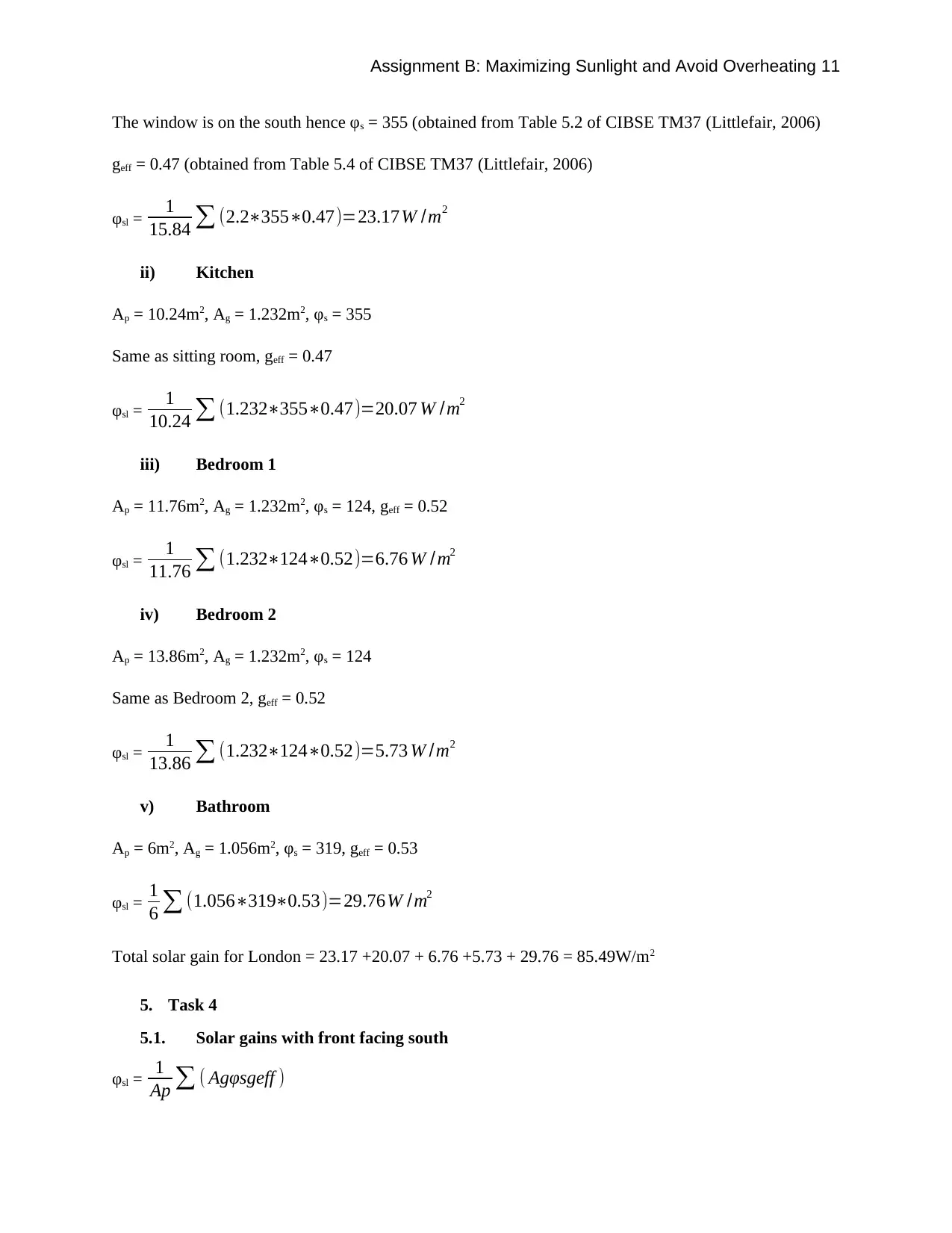
Assignment B: Maximizing Sunlight and Avoid Overheating 11
The window is on the south hence φs = 355 (obtained from Table 5.2 of CIBSE TM37 (Littlefair, 2006)
geff = 0.47 (obtained from Table 5.4 of CIBSE TM37 (Littlefair, 2006)
φsl = 1
15.84 ∑ (2.2∗355∗0.47)=23.17W /m2
ii) Kitchen
Ap = 10.24m2, Ag = 1.232m2, φs = 355
Same as sitting room, geff = 0.47
φsl = 1
10.24 ∑ (1.232∗355∗0.47)=20.07 W /m2
iii) Bedroom 1
Ap = 11.76m2, Ag = 1.232m2, φs = 124, geff = 0.52
φsl = 1
11.76 ∑ (1.232∗124∗0.52)=6.76 W / m2
iv) Bedroom 2
Ap = 13.86m2, Ag = 1.232m2, φs = 124
Same as Bedroom 2, geff = 0.52
φsl = 1
13.86 ∑ (1.232∗124∗0.52)=5.73 W /m2
v) Bathroom
Ap = 6m2, Ag = 1.056m2, φs = 319, geff = 0.53
φsl = 1
6 ∑ (1.056∗319∗0.53)=29.76W /m2
Total solar gain for London = 23.17 +20.07 + 6.76 +5.73 + 29.76 = 85.49W/m2
5. Task 4
5.1. Solar gains with front facing south
φsl = 1
Ap ∑ ( Agφsgeff )
The window is on the south hence φs = 355 (obtained from Table 5.2 of CIBSE TM37 (Littlefair, 2006)
geff = 0.47 (obtained from Table 5.4 of CIBSE TM37 (Littlefair, 2006)
φsl = 1
15.84 ∑ (2.2∗355∗0.47)=23.17W /m2
ii) Kitchen
Ap = 10.24m2, Ag = 1.232m2, φs = 355
Same as sitting room, geff = 0.47
φsl = 1
10.24 ∑ (1.232∗355∗0.47)=20.07 W /m2
iii) Bedroom 1
Ap = 11.76m2, Ag = 1.232m2, φs = 124, geff = 0.52
φsl = 1
11.76 ∑ (1.232∗124∗0.52)=6.76 W / m2
iv) Bedroom 2
Ap = 13.86m2, Ag = 1.232m2, φs = 124
Same as Bedroom 2, geff = 0.52
φsl = 1
13.86 ∑ (1.232∗124∗0.52)=5.73 W /m2
v) Bathroom
Ap = 6m2, Ag = 1.056m2, φs = 319, geff = 0.53
φsl = 1
6 ∑ (1.056∗319∗0.53)=29.76W /m2
Total solar gain for London = 23.17 +20.07 + 6.76 +5.73 + 29.76 = 85.49W/m2
5. Task 4
5.1. Solar gains with front facing south
φsl = 1
Ap ∑ ( Agφsgeff )
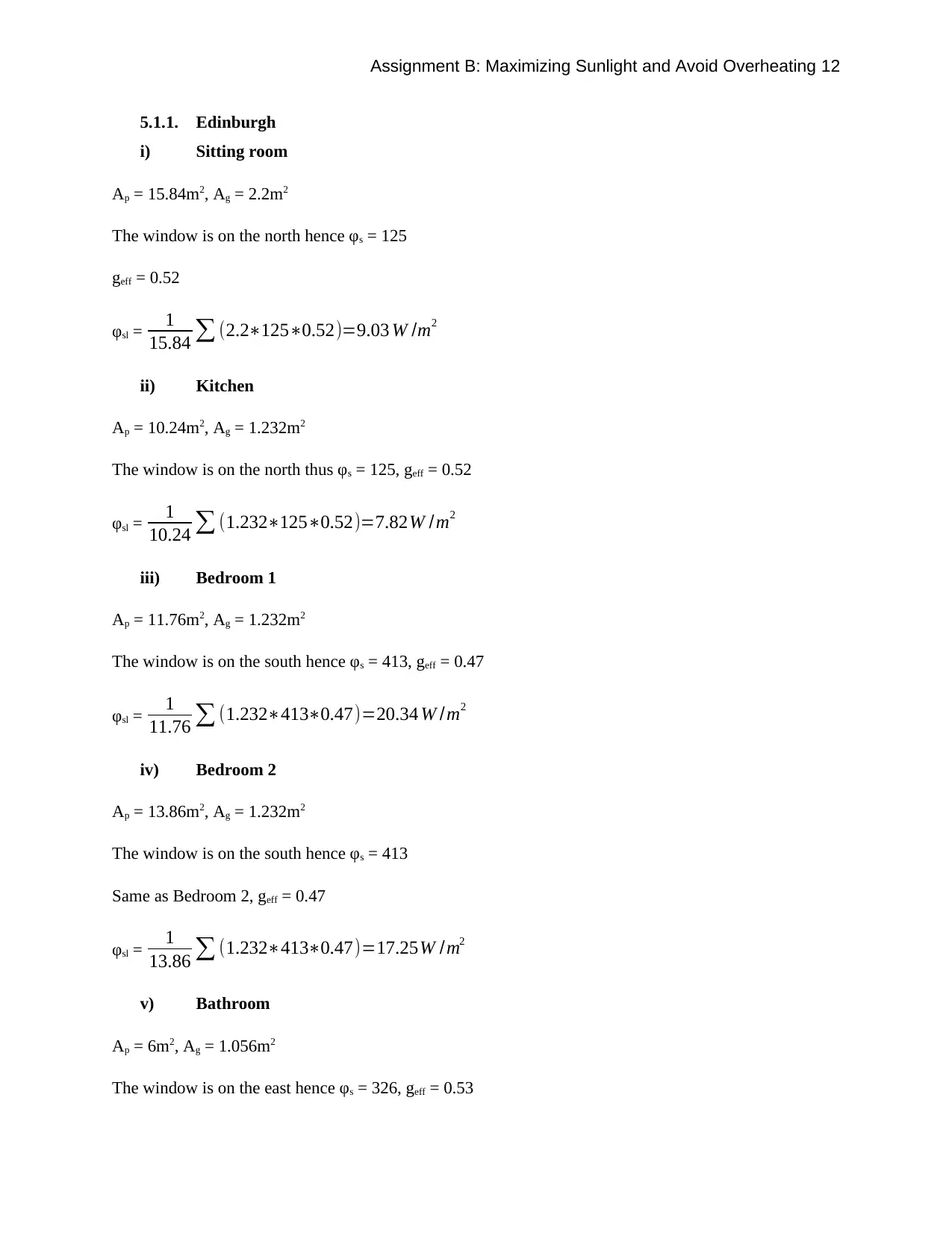
Assignment B: Maximizing Sunlight and Avoid Overheating 12
5.1.1. Edinburgh
i) Sitting room
Ap = 15.84m2, Ag = 2.2m2
The window is on the north hence φs = 125
geff = 0.52
φsl = 1
15.84 ∑ (2.2∗125∗0.52)=9.03 W /m2
ii) Kitchen
Ap = 10.24m2, Ag = 1.232m2
The window is on the north thus φs = 125, geff = 0.52
φsl = 1
10.24 ∑ (1.232∗125∗0.52)=7.82W /m2
iii) Bedroom 1
Ap = 11.76m2, Ag = 1.232m2
The window is on the south hence φs = 413, geff = 0.47
φsl = 1
11.76 ∑ (1.232∗413∗0.47)=20.34 W /m2
iv) Bedroom 2
Ap = 13.86m2, Ag = 1.232m2
The window is on the south hence φs = 413
Same as Bedroom 2, geff = 0.47
φsl = 1
13.86 ∑ (1.232∗413∗0.47)=17.25W /m2
v) Bathroom
Ap = 6m2, Ag = 1.056m2
The window is on the east hence φs = 326, geff = 0.53
5.1.1. Edinburgh
i) Sitting room
Ap = 15.84m2, Ag = 2.2m2
The window is on the north hence φs = 125
geff = 0.52
φsl = 1
15.84 ∑ (2.2∗125∗0.52)=9.03 W /m2
ii) Kitchen
Ap = 10.24m2, Ag = 1.232m2
The window is on the north thus φs = 125, geff = 0.52
φsl = 1
10.24 ∑ (1.232∗125∗0.52)=7.82W /m2
iii) Bedroom 1
Ap = 11.76m2, Ag = 1.232m2
The window is on the south hence φs = 413, geff = 0.47
φsl = 1
11.76 ∑ (1.232∗413∗0.47)=20.34 W /m2
iv) Bedroom 2
Ap = 13.86m2, Ag = 1.232m2
The window is on the south hence φs = 413
Same as Bedroom 2, geff = 0.47
φsl = 1
13.86 ∑ (1.232∗413∗0.47)=17.25W /m2
v) Bathroom
Ap = 6m2, Ag = 1.056m2
The window is on the east hence φs = 326, geff = 0.53
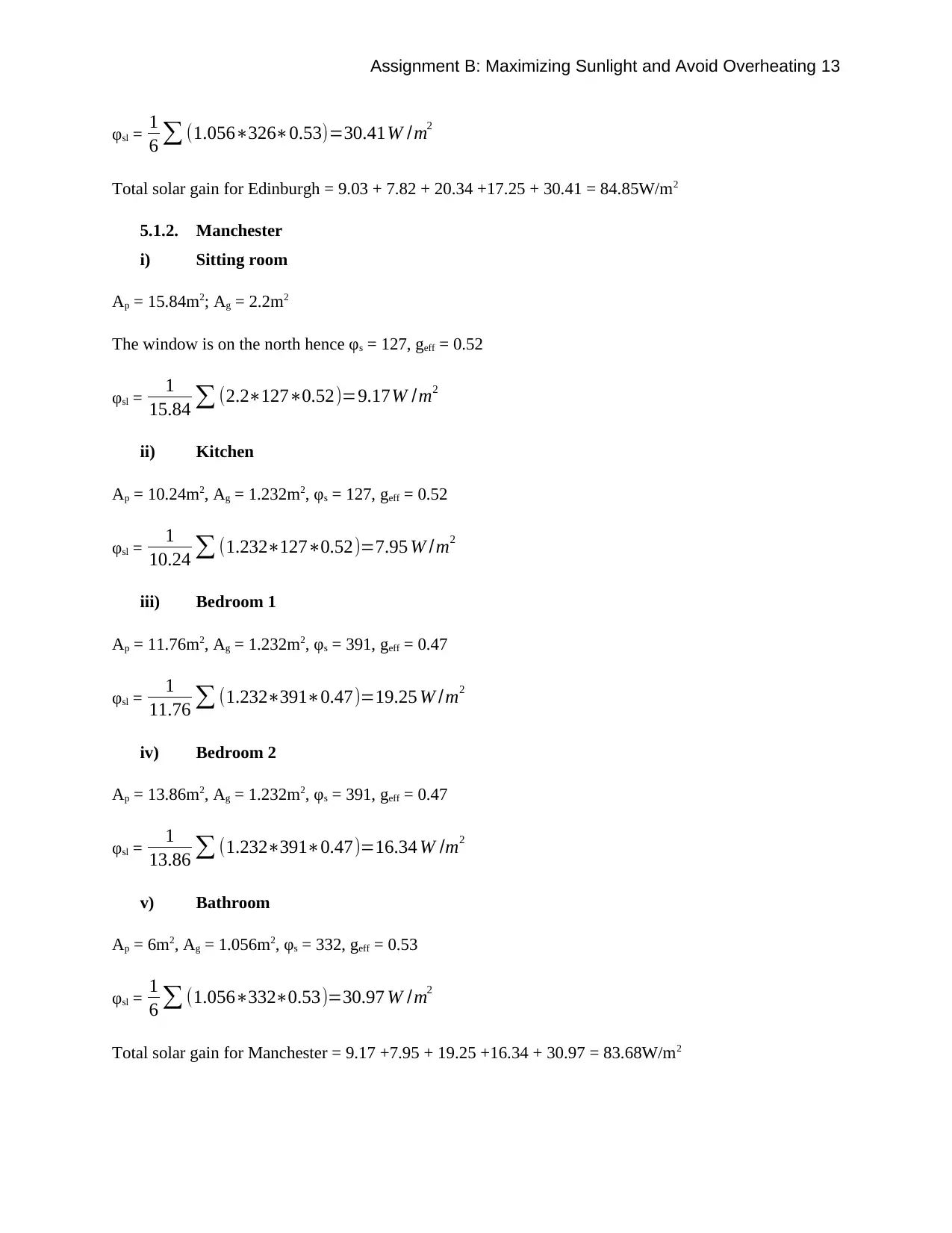
Assignment B: Maximizing Sunlight and Avoid Overheating 13
φsl = 1
6 ∑ (1.056∗326∗0.53)=30.41W /m2
Total solar gain for Edinburgh = 9.03 + 7.82 + 20.34 +17.25 + 30.41 = 84.85W/m2
5.1.2. Manchester
i) Sitting room
Ap = 15.84m2; Ag = 2.2m2
The window is on the north hence φs = 127, geff = 0.52
φsl = 1
15.84 ∑ (2.2∗127∗0.52)=9.17W /m2
ii) Kitchen
Ap = 10.24m2, Ag = 1.232m2, φs = 127, geff = 0.52
φsl = 1
10.24 ∑ (1.232∗127∗0.52)=7.95 W /m2
iii) Bedroom 1
Ap = 11.76m2, Ag = 1.232m2, φs = 391, geff = 0.47
φsl = 1
11.76 ∑ (1.232∗391∗0.47)=19.25 W /m2
iv) Bedroom 2
Ap = 13.86m2, Ag = 1.232m2, φs = 391, geff = 0.47
φsl = 1
13.86 ∑ (1.232∗391∗0.47)=16.34 W /m2
v) Bathroom
Ap = 6m2, Ag = 1.056m2, φs = 332, geff = 0.53
φsl = 1
6 ∑ (1.056∗332∗0.53)=30.97 W /m2
Total solar gain for Manchester = 9.17 +7.95 + 19.25 +16.34 + 30.97 = 83.68W/m2
φsl = 1
6 ∑ (1.056∗326∗0.53)=30.41W /m2
Total solar gain for Edinburgh = 9.03 + 7.82 + 20.34 +17.25 + 30.41 = 84.85W/m2
5.1.2. Manchester
i) Sitting room
Ap = 15.84m2; Ag = 2.2m2
The window is on the north hence φs = 127, geff = 0.52
φsl = 1
15.84 ∑ (2.2∗127∗0.52)=9.17W /m2
ii) Kitchen
Ap = 10.24m2, Ag = 1.232m2, φs = 127, geff = 0.52
φsl = 1
10.24 ∑ (1.232∗127∗0.52)=7.95 W /m2
iii) Bedroom 1
Ap = 11.76m2, Ag = 1.232m2, φs = 391, geff = 0.47
φsl = 1
11.76 ∑ (1.232∗391∗0.47)=19.25 W /m2
iv) Bedroom 2
Ap = 13.86m2, Ag = 1.232m2, φs = 391, geff = 0.47
φsl = 1
13.86 ∑ (1.232∗391∗0.47)=16.34 W /m2
v) Bathroom
Ap = 6m2, Ag = 1.056m2, φs = 332, geff = 0.53
φsl = 1
6 ∑ (1.056∗332∗0.53)=30.97 W /m2
Total solar gain for Manchester = 9.17 +7.95 + 19.25 +16.34 + 30.97 = 83.68W/m2
Paraphrase This Document
Need a fresh take? Get an instant paraphrase of this document with our AI Paraphraser
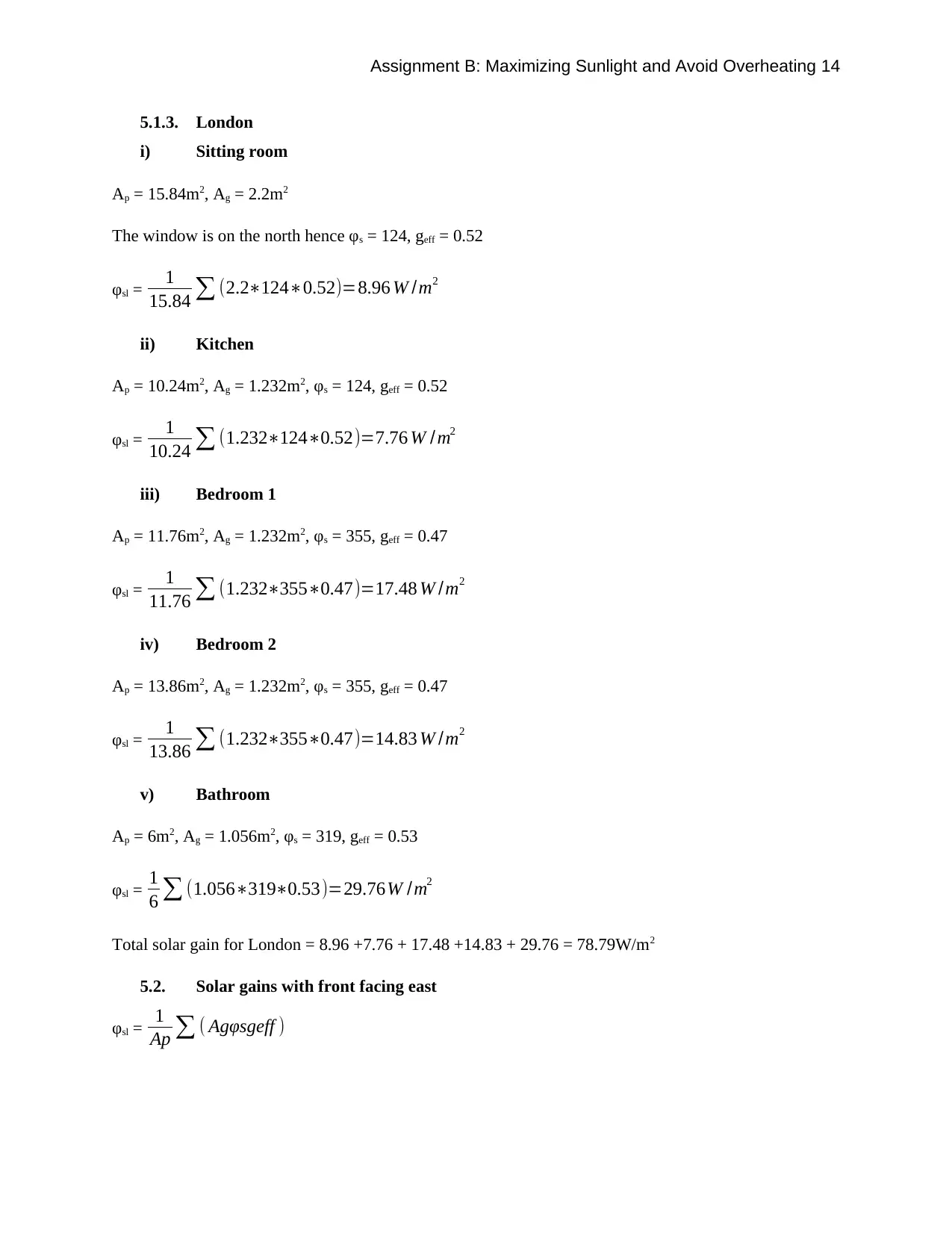
Assignment B: Maximizing Sunlight and Avoid Overheating 14
5.1.3. London
i) Sitting room
Ap = 15.84m2, Ag = 2.2m2
The window is on the north hence φs = 124, geff = 0.52
φsl = 1
15.84 ∑ (2.2∗124∗0.52)=8.96 W /m2
ii) Kitchen
Ap = 10.24m2, Ag = 1.232m2, φs = 124, geff = 0.52
φsl = 1
10.24 ∑ (1.232∗124∗0.52)=7.76 W / m2
iii) Bedroom 1
Ap = 11.76m2, Ag = 1.232m2, φs = 355, geff = 0.47
φsl = 1
11.76 ∑ (1.232∗355∗0.47)=17.48 W /m2
iv) Bedroom 2
Ap = 13.86m2, Ag = 1.232m2, φs = 355, geff = 0.47
φsl = 1
13.86 ∑ (1.232∗355∗0.47)=14.83 W /m2
v) Bathroom
Ap = 6m2, Ag = 1.056m2, φs = 319, geff = 0.53
φsl = 1
6 ∑ (1.056∗319∗0.53)=29.76W /m2
Total solar gain for London = 8.96 +7.76 + 17.48 +14.83 + 29.76 = 78.79W/m2
5.2. Solar gains with front facing east
φsl = 1
Ap ∑ ( Agφsgeff )
5.1.3. London
i) Sitting room
Ap = 15.84m2, Ag = 2.2m2
The window is on the north hence φs = 124, geff = 0.52
φsl = 1
15.84 ∑ (2.2∗124∗0.52)=8.96 W /m2
ii) Kitchen
Ap = 10.24m2, Ag = 1.232m2, φs = 124, geff = 0.52
φsl = 1
10.24 ∑ (1.232∗124∗0.52)=7.76 W / m2
iii) Bedroom 1
Ap = 11.76m2, Ag = 1.232m2, φs = 355, geff = 0.47
φsl = 1
11.76 ∑ (1.232∗355∗0.47)=17.48 W /m2
iv) Bedroom 2
Ap = 13.86m2, Ag = 1.232m2, φs = 355, geff = 0.47
φsl = 1
13.86 ∑ (1.232∗355∗0.47)=14.83 W /m2
v) Bathroom
Ap = 6m2, Ag = 1.056m2, φs = 319, geff = 0.53
φsl = 1
6 ∑ (1.056∗319∗0.53)=29.76W /m2
Total solar gain for London = 8.96 +7.76 + 17.48 +14.83 + 29.76 = 78.79W/m2
5.2. Solar gains with front facing east
φsl = 1
Ap ∑ ( Agφsgeff )
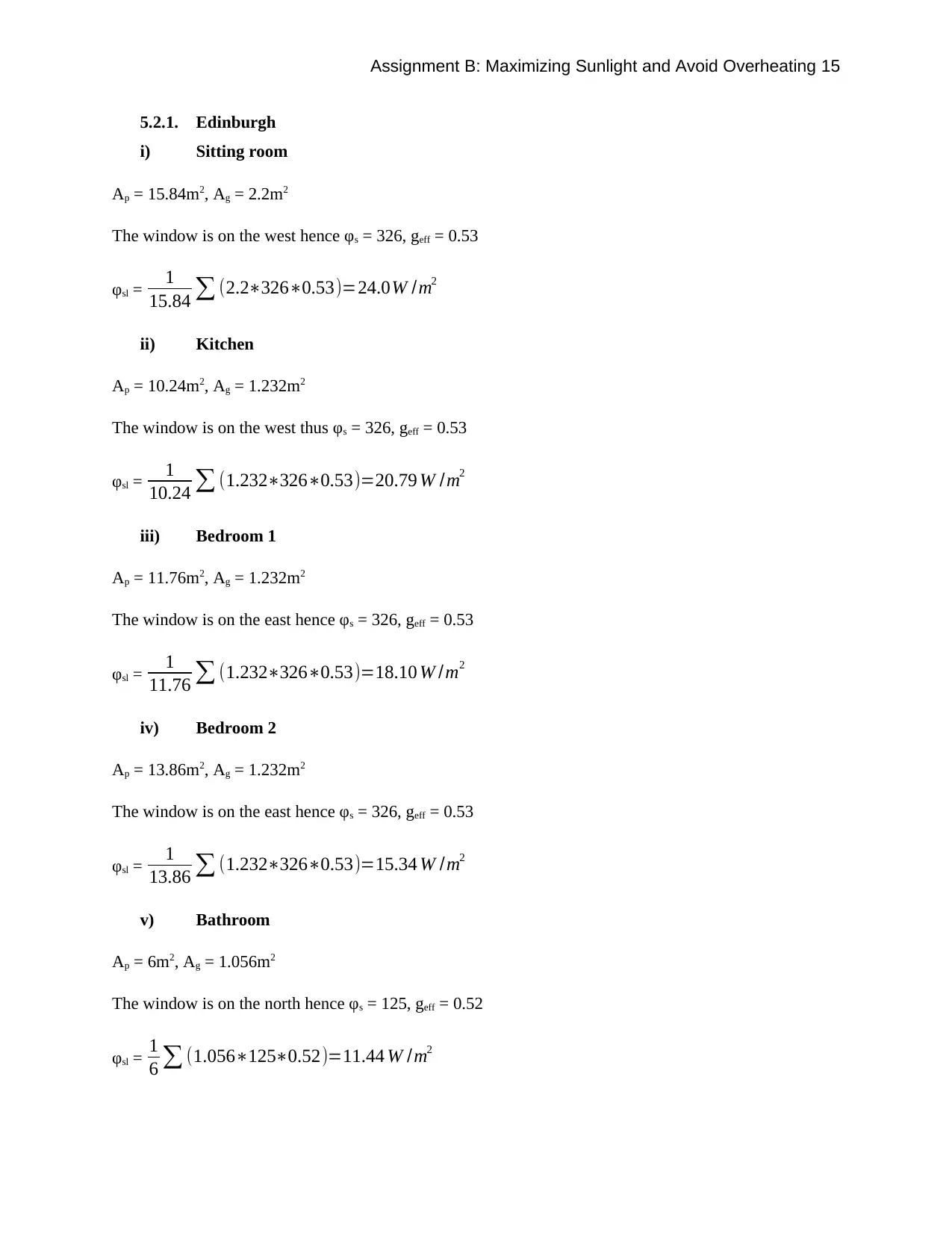
Assignment B: Maximizing Sunlight and Avoid Overheating 15
5.2.1. Edinburgh
i) Sitting room
Ap = 15.84m2, Ag = 2.2m2
The window is on the west hence φs = 326, geff = 0.53
φsl = 1
15.84 ∑ (2.2∗326∗0.53)=24.0W /m2
ii) Kitchen
Ap = 10.24m2, Ag = 1.232m2
The window is on the west thus φs = 326, geff = 0.53
φsl = 1
10.24 ∑ (1.232∗326∗0.53)=20.79 W /m2
iii) Bedroom 1
Ap = 11.76m2, Ag = 1.232m2
The window is on the east hence φs = 326, geff = 0.53
φsl = 1
11.76 ∑ (1.232∗326∗0.53)=18.10 W /m2
iv) Bedroom 2
Ap = 13.86m2, Ag = 1.232m2
The window is on the east hence φs = 326, geff = 0.53
φsl = 1
13.86 ∑ (1.232∗326∗0.53)=15.34 W /m2
v) Bathroom
Ap = 6m2, Ag = 1.056m2
The window is on the north hence φs = 125, geff = 0.52
φsl = 1
6 ∑ (1.056∗125∗0.52)=11.44 W /m2
5.2.1. Edinburgh
i) Sitting room
Ap = 15.84m2, Ag = 2.2m2
The window is on the west hence φs = 326, geff = 0.53
φsl = 1
15.84 ∑ (2.2∗326∗0.53)=24.0W /m2
ii) Kitchen
Ap = 10.24m2, Ag = 1.232m2
The window is on the west thus φs = 326, geff = 0.53
φsl = 1
10.24 ∑ (1.232∗326∗0.53)=20.79 W /m2
iii) Bedroom 1
Ap = 11.76m2, Ag = 1.232m2
The window is on the east hence φs = 326, geff = 0.53
φsl = 1
11.76 ∑ (1.232∗326∗0.53)=18.10 W /m2
iv) Bedroom 2
Ap = 13.86m2, Ag = 1.232m2
The window is on the east hence φs = 326, geff = 0.53
φsl = 1
13.86 ∑ (1.232∗326∗0.53)=15.34 W /m2
v) Bathroom
Ap = 6m2, Ag = 1.056m2
The window is on the north hence φs = 125, geff = 0.52
φsl = 1
6 ∑ (1.056∗125∗0.52)=11.44 W /m2
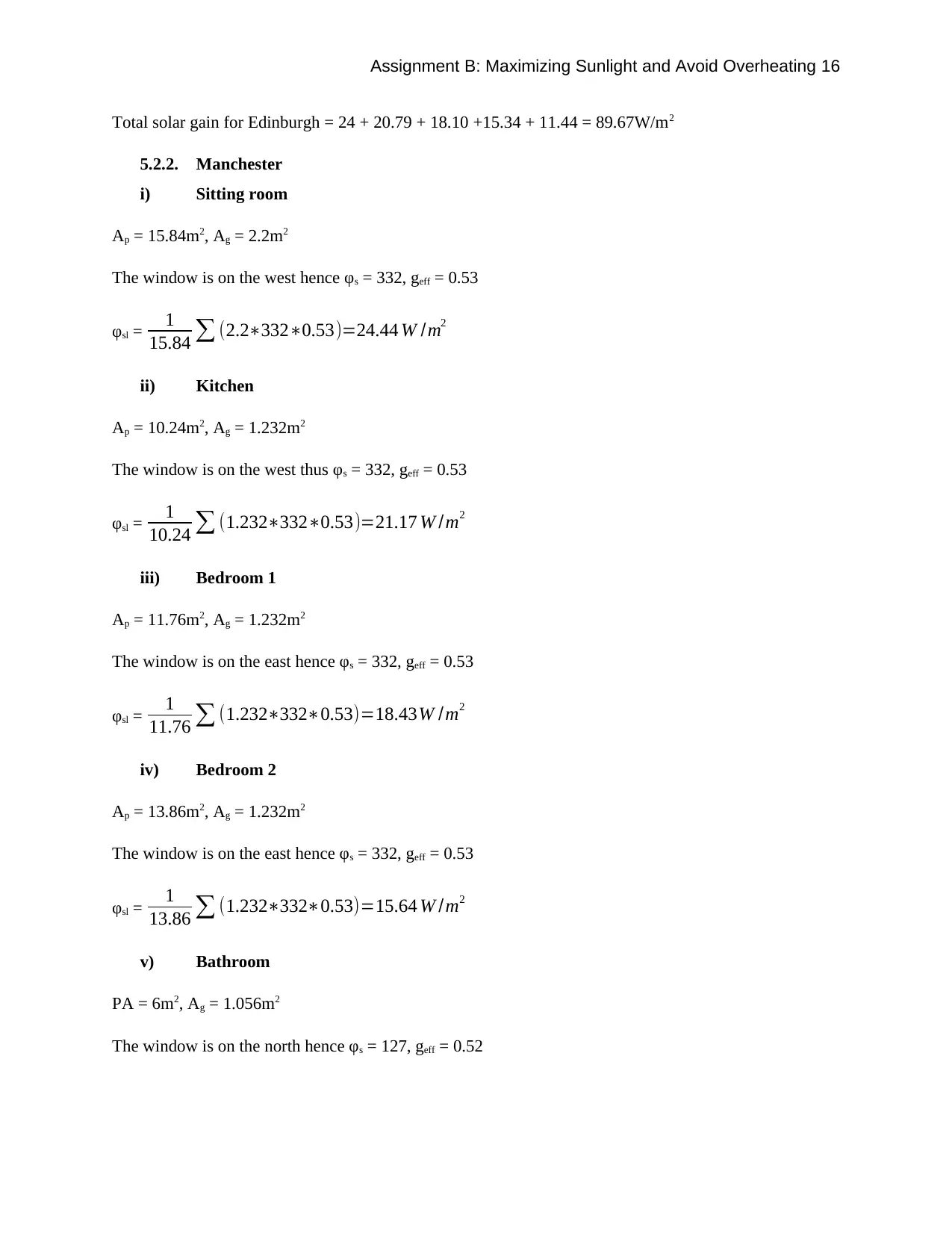
Assignment B: Maximizing Sunlight and Avoid Overheating 16
Total solar gain for Edinburgh = 24 + 20.79 + 18.10 +15.34 + 11.44 = 89.67W/m2
5.2.2. Manchester
i) Sitting room
Ap = 15.84m2, Ag = 2.2m2
The window is on the west hence φs = 332, geff = 0.53
φsl = 1
15.84 ∑ (2.2∗332∗0.53)=24.44 W /m2
ii) Kitchen
Ap = 10.24m2, Ag = 1.232m2
The window is on the west thus φs = 332, geff = 0.53
φsl = 1
10.24 ∑ (1.232∗332∗0.53)=21.17 W /m2
iii) Bedroom 1
Ap = 11.76m2, Ag = 1.232m2
The window is on the east hence φs = 332, geff = 0.53
φsl = 1
11.76 ∑ (1.232∗332∗0.53)=18.43W /m2
iv) Bedroom 2
Ap = 13.86m2, Ag = 1.232m2
The window is on the east hence φs = 332, geff = 0.53
φsl = 1
13.86 ∑ (1.232∗332∗0.53)=15.64 W /m2
v) Bathroom
PA = 6m2, Ag = 1.056m2
The window is on the north hence φs = 127, geff = 0.52
Total solar gain for Edinburgh = 24 + 20.79 + 18.10 +15.34 + 11.44 = 89.67W/m2
5.2.2. Manchester
i) Sitting room
Ap = 15.84m2, Ag = 2.2m2
The window is on the west hence φs = 332, geff = 0.53
φsl = 1
15.84 ∑ (2.2∗332∗0.53)=24.44 W /m2
ii) Kitchen
Ap = 10.24m2, Ag = 1.232m2
The window is on the west thus φs = 332, geff = 0.53
φsl = 1
10.24 ∑ (1.232∗332∗0.53)=21.17 W /m2
iii) Bedroom 1
Ap = 11.76m2, Ag = 1.232m2
The window is on the east hence φs = 332, geff = 0.53
φsl = 1
11.76 ∑ (1.232∗332∗0.53)=18.43W /m2
iv) Bedroom 2
Ap = 13.86m2, Ag = 1.232m2
The window is on the east hence φs = 332, geff = 0.53
φsl = 1
13.86 ∑ (1.232∗332∗0.53)=15.64 W /m2
v) Bathroom
PA = 6m2, Ag = 1.056m2
The window is on the north hence φs = 127, geff = 0.52
Secure Best Marks with AI Grader
Need help grading? Try our AI Grader for instant feedback on your assignments.
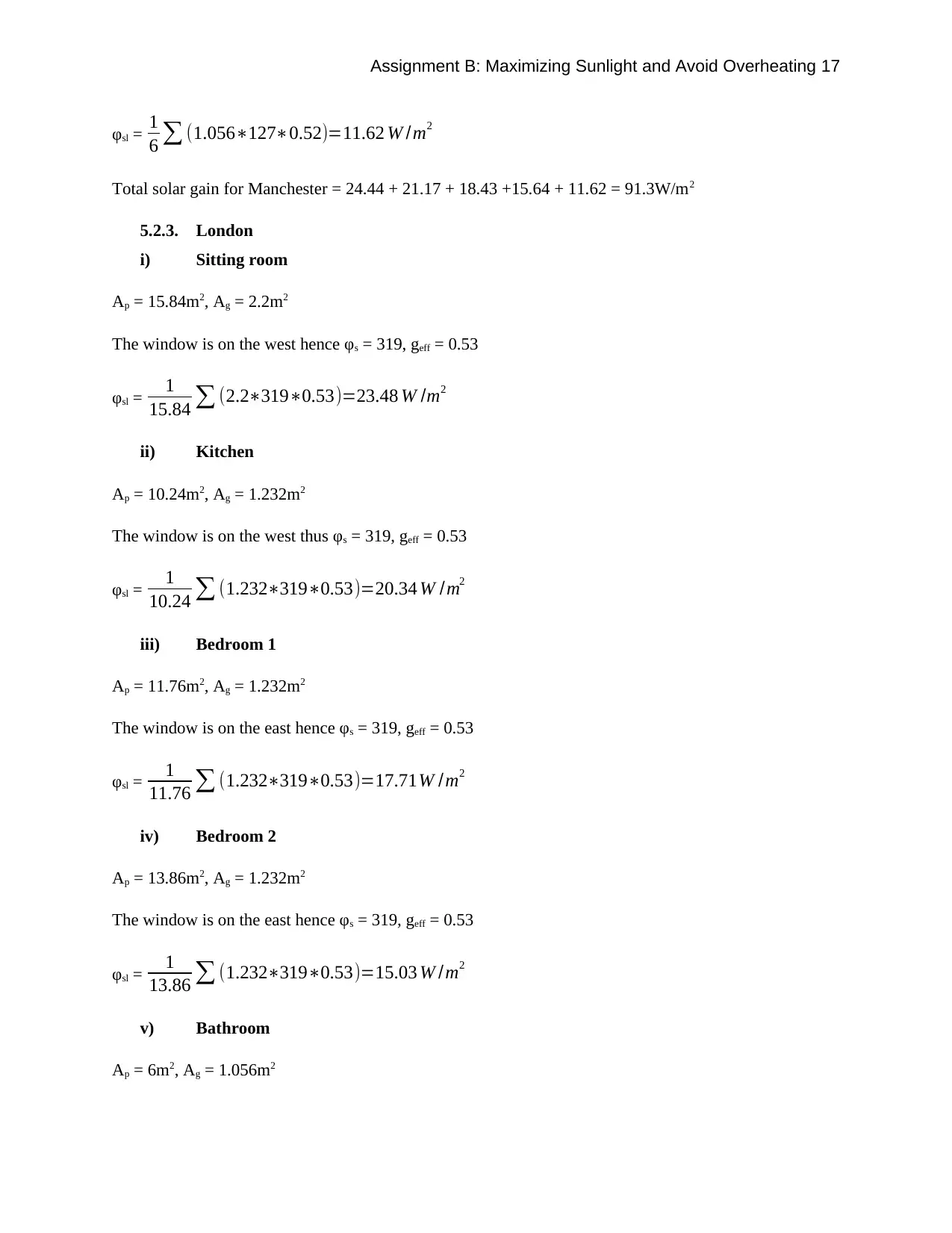
Assignment B: Maximizing Sunlight and Avoid Overheating 17
φsl = 1
6 ∑ (1.056∗127∗0.52)=11.62 W /m2
Total solar gain for Manchester = 24.44 + 21.17 + 18.43 +15.64 + 11.62 = 91.3W/m2
5.2.3. London
i) Sitting room
Ap = 15.84m2, Ag = 2.2m2
The window is on the west hence φs = 319, geff = 0.53
φsl = 1
15.84 ∑ (2.2∗319∗0.53)=23.48 W /m2
ii) Kitchen
Ap = 10.24m2, Ag = 1.232m2
The window is on the west thus φs = 319, geff = 0.53
φsl = 1
10.24 ∑ (1.232∗319∗0.53)=20.34 W /m2
iii) Bedroom 1
Ap = 11.76m2, Ag = 1.232m2
The window is on the east hence φs = 319, geff = 0.53
φsl = 1
11.76 ∑ (1.232∗319∗0.53)=17.71W /m2
iv) Bedroom 2
Ap = 13.86m2, Ag = 1.232m2
The window is on the east hence φs = 319, geff = 0.53
φsl = 1
13.86 ∑ (1.232∗319∗0.53)=15.03 W /m2
v) Bathroom
Ap = 6m2, Ag = 1.056m2
φsl = 1
6 ∑ (1.056∗127∗0.52)=11.62 W /m2
Total solar gain for Manchester = 24.44 + 21.17 + 18.43 +15.64 + 11.62 = 91.3W/m2
5.2.3. London
i) Sitting room
Ap = 15.84m2, Ag = 2.2m2
The window is on the west hence φs = 319, geff = 0.53
φsl = 1
15.84 ∑ (2.2∗319∗0.53)=23.48 W /m2
ii) Kitchen
Ap = 10.24m2, Ag = 1.232m2
The window is on the west thus φs = 319, geff = 0.53
φsl = 1
10.24 ∑ (1.232∗319∗0.53)=20.34 W /m2
iii) Bedroom 1
Ap = 11.76m2, Ag = 1.232m2
The window is on the east hence φs = 319, geff = 0.53
φsl = 1
11.76 ∑ (1.232∗319∗0.53)=17.71W /m2
iv) Bedroom 2
Ap = 13.86m2, Ag = 1.232m2
The window is on the east hence φs = 319, geff = 0.53
φsl = 1
13.86 ∑ (1.232∗319∗0.53)=15.03 W /m2
v) Bathroom
Ap = 6m2, Ag = 1.056m2
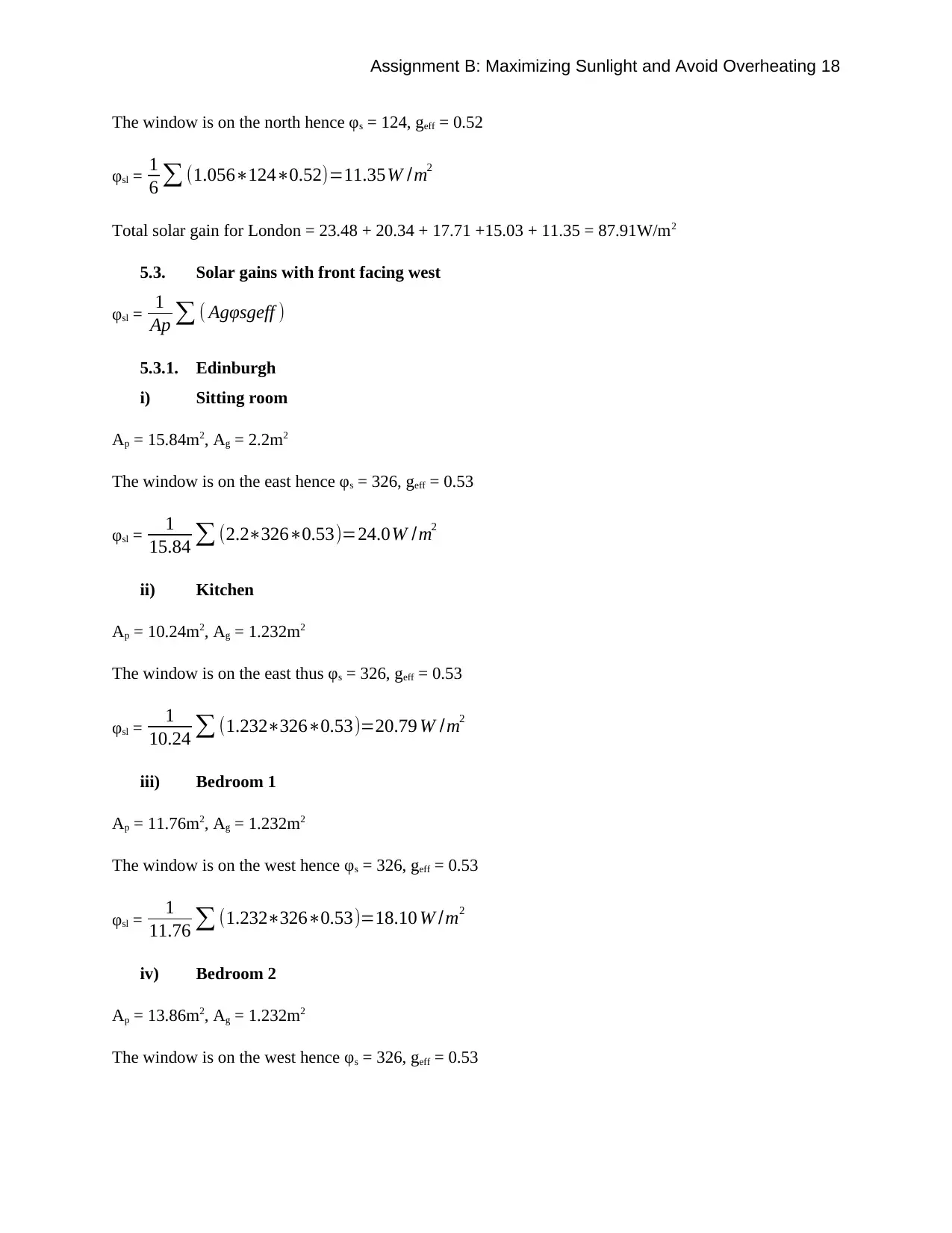
Assignment B: Maximizing Sunlight and Avoid Overheating 18
The window is on the north hence φs = 124, geff = 0.52
φsl = 1
6 ∑ (1.056∗124∗0.52)=11.35W /m2
Total solar gain for London = 23.48 + 20.34 + 17.71 +15.03 + 11.35 = 87.91W/m2
5.3. Solar gains with front facing west
φsl = 1
Ap ∑ ( Agφsgeff )
5.3.1. Edinburgh
i) Sitting room
Ap = 15.84m2, Ag = 2.2m2
The window is on the east hence φs = 326, geff = 0.53
φsl = 1
15.84 ∑ (2.2∗326∗0.53)=24.0W /m2
ii) Kitchen
Ap = 10.24m2, Ag = 1.232m2
The window is on the east thus φs = 326, geff = 0.53
φsl = 1
10.24 ∑ (1.232∗326∗0.53)=20.79 W /m2
iii) Bedroom 1
Ap = 11.76m2, Ag = 1.232m2
The window is on the west hence φs = 326, geff = 0.53
φsl = 1
11.76 ∑ (1.232∗326∗0.53)=18.10 W /m2
iv) Bedroom 2
Ap = 13.86m2, Ag = 1.232m2
The window is on the west hence φs = 326, geff = 0.53
The window is on the north hence φs = 124, geff = 0.52
φsl = 1
6 ∑ (1.056∗124∗0.52)=11.35W /m2
Total solar gain for London = 23.48 + 20.34 + 17.71 +15.03 + 11.35 = 87.91W/m2
5.3. Solar gains with front facing west
φsl = 1
Ap ∑ ( Agφsgeff )
5.3.1. Edinburgh
i) Sitting room
Ap = 15.84m2, Ag = 2.2m2
The window is on the east hence φs = 326, geff = 0.53
φsl = 1
15.84 ∑ (2.2∗326∗0.53)=24.0W /m2
ii) Kitchen
Ap = 10.24m2, Ag = 1.232m2
The window is on the east thus φs = 326, geff = 0.53
φsl = 1
10.24 ∑ (1.232∗326∗0.53)=20.79 W /m2
iii) Bedroom 1
Ap = 11.76m2, Ag = 1.232m2
The window is on the west hence φs = 326, geff = 0.53
φsl = 1
11.76 ∑ (1.232∗326∗0.53)=18.10 W /m2
iv) Bedroom 2
Ap = 13.86m2, Ag = 1.232m2
The window is on the west hence φs = 326, geff = 0.53
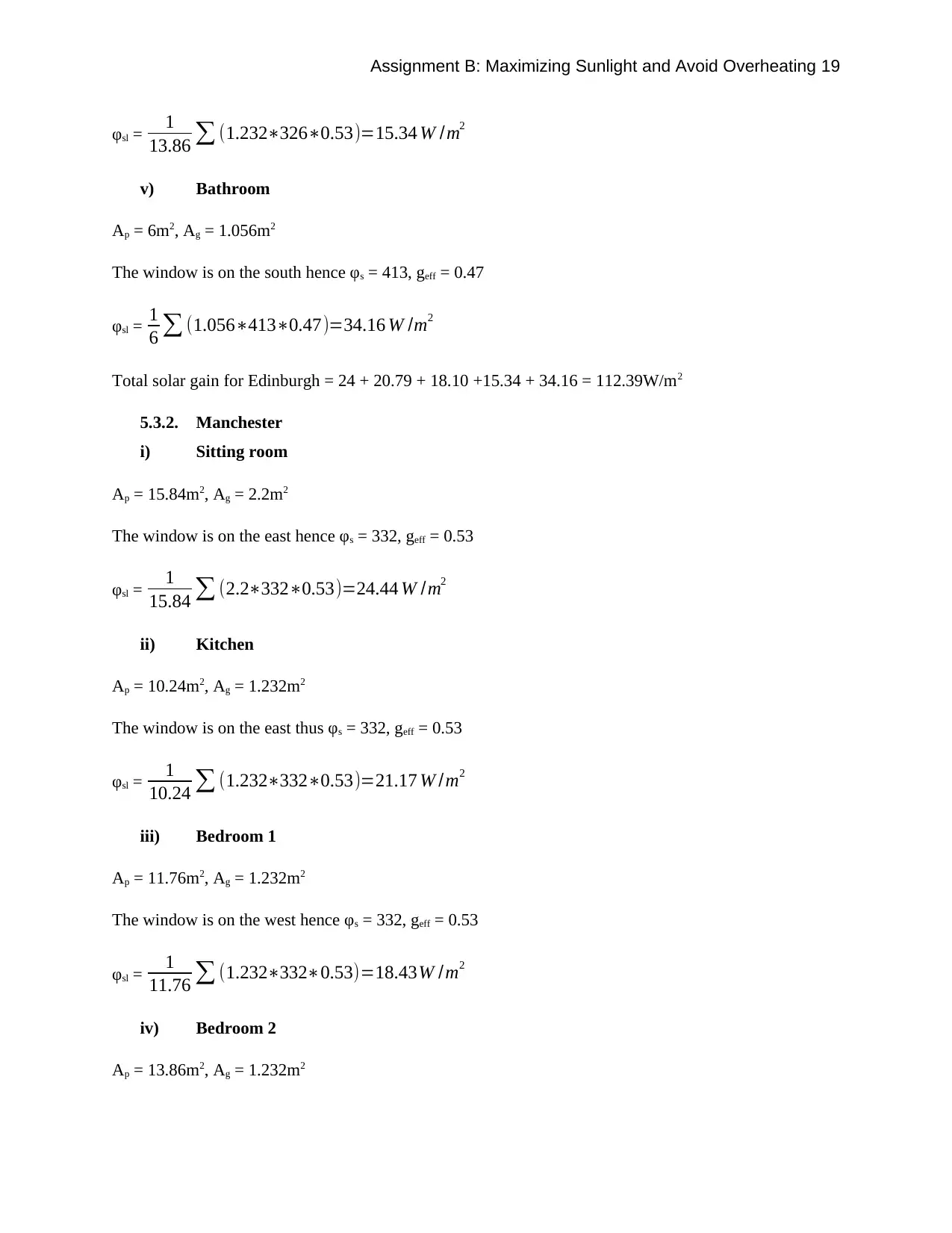
Assignment B: Maximizing Sunlight and Avoid Overheating 19
φsl = 1
13.86 ∑ (1.232∗326∗0.53)=15.34 W /m2
v) Bathroom
Ap = 6m2, Ag = 1.056m2
The window is on the south hence φs = 413, geff = 0.47
φsl = 1
6 ∑ (1.056∗413∗0.47)=34.16 W /m2
Total solar gain for Edinburgh = 24 + 20.79 + 18.10 +15.34 + 34.16 = 112.39W/m2
5.3.2. Manchester
i) Sitting room
Ap = 15.84m2, Ag = 2.2m2
The window is on the east hence φs = 332, geff = 0.53
φsl = 1
15.84 ∑ (2.2∗332∗0.53)=24.44 W /m2
ii) Kitchen
Ap = 10.24m2, Ag = 1.232m2
The window is on the east thus φs = 332, geff = 0.53
φsl = 1
10.24 ∑ (1.232∗332∗0.53)=21.17 W /m2
iii) Bedroom 1
Ap = 11.76m2, Ag = 1.232m2
The window is on the west hence φs = 332, geff = 0.53
φsl = 1
11.76 ∑ (1.232∗332∗0.53)=18.43W /m2
iv) Bedroom 2
Ap = 13.86m2, Ag = 1.232m2
φsl = 1
13.86 ∑ (1.232∗326∗0.53)=15.34 W /m2
v) Bathroom
Ap = 6m2, Ag = 1.056m2
The window is on the south hence φs = 413, geff = 0.47
φsl = 1
6 ∑ (1.056∗413∗0.47)=34.16 W /m2
Total solar gain for Edinburgh = 24 + 20.79 + 18.10 +15.34 + 34.16 = 112.39W/m2
5.3.2. Manchester
i) Sitting room
Ap = 15.84m2, Ag = 2.2m2
The window is on the east hence φs = 332, geff = 0.53
φsl = 1
15.84 ∑ (2.2∗332∗0.53)=24.44 W /m2
ii) Kitchen
Ap = 10.24m2, Ag = 1.232m2
The window is on the east thus φs = 332, geff = 0.53
φsl = 1
10.24 ∑ (1.232∗332∗0.53)=21.17 W /m2
iii) Bedroom 1
Ap = 11.76m2, Ag = 1.232m2
The window is on the west hence φs = 332, geff = 0.53
φsl = 1
11.76 ∑ (1.232∗332∗0.53)=18.43W /m2
iv) Bedroom 2
Ap = 13.86m2, Ag = 1.232m2
Paraphrase This Document
Need a fresh take? Get an instant paraphrase of this document with our AI Paraphraser
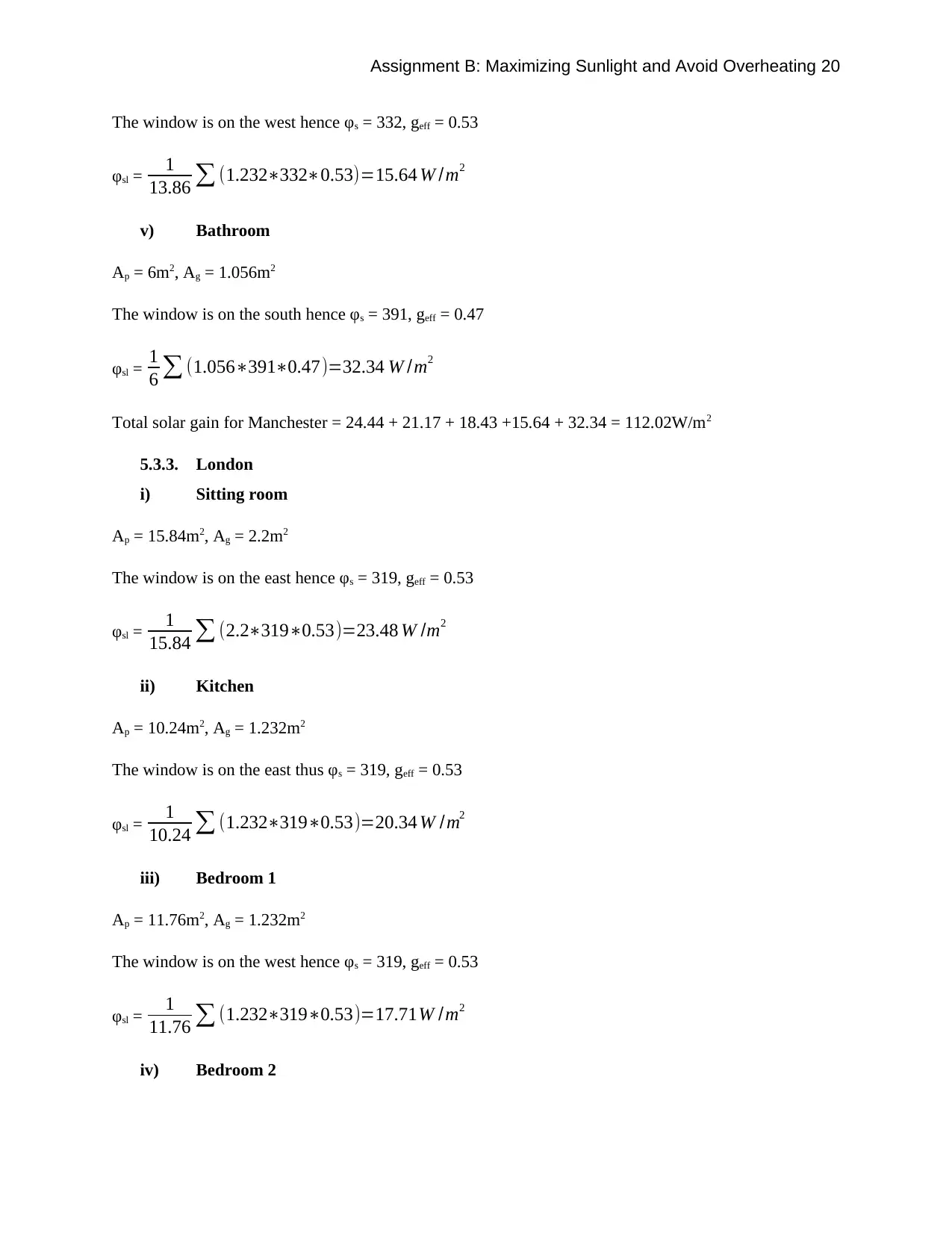
Assignment B: Maximizing Sunlight and Avoid Overheating 20
The window is on the west hence φs = 332, geff = 0.53
φsl = 1
13.86 ∑ (1.232∗332∗0.53)=15.64 W /m2
v) Bathroom
Ap = 6m2, Ag = 1.056m2
The window is on the south hence φs = 391, geff = 0.47
φsl = 1
6 ∑ (1.056∗391∗0.47)=32.34 W /m2
Total solar gain for Manchester = 24.44 + 21.17 + 18.43 +15.64 + 32.34 = 112.02W/m2
5.3.3. London
i) Sitting room
Ap = 15.84m2, Ag = 2.2m2
The window is on the east hence φs = 319, geff = 0.53
φsl = 1
15.84 ∑ (2.2∗319∗0.53)=23.48 W /m2
ii) Kitchen
Ap = 10.24m2, Ag = 1.232m2
The window is on the east thus φs = 319, geff = 0.53
φsl = 1
10.24 ∑ (1.232∗319∗0.53)=20.34 W /m2
iii) Bedroom 1
Ap = 11.76m2, Ag = 1.232m2
The window is on the west hence φs = 319, geff = 0.53
φsl = 1
11.76 ∑ (1.232∗319∗0.53)=17.71W /m2
iv) Bedroom 2
The window is on the west hence φs = 332, geff = 0.53
φsl = 1
13.86 ∑ (1.232∗332∗0.53)=15.64 W /m2
v) Bathroom
Ap = 6m2, Ag = 1.056m2
The window is on the south hence φs = 391, geff = 0.47
φsl = 1
6 ∑ (1.056∗391∗0.47)=32.34 W /m2
Total solar gain for Manchester = 24.44 + 21.17 + 18.43 +15.64 + 32.34 = 112.02W/m2
5.3.3. London
i) Sitting room
Ap = 15.84m2, Ag = 2.2m2
The window is on the east hence φs = 319, geff = 0.53
φsl = 1
15.84 ∑ (2.2∗319∗0.53)=23.48 W /m2
ii) Kitchen
Ap = 10.24m2, Ag = 1.232m2
The window is on the east thus φs = 319, geff = 0.53
φsl = 1
10.24 ∑ (1.232∗319∗0.53)=20.34 W /m2
iii) Bedroom 1
Ap = 11.76m2, Ag = 1.232m2
The window is on the west hence φs = 319, geff = 0.53
φsl = 1
11.76 ∑ (1.232∗319∗0.53)=17.71W /m2
iv) Bedroom 2
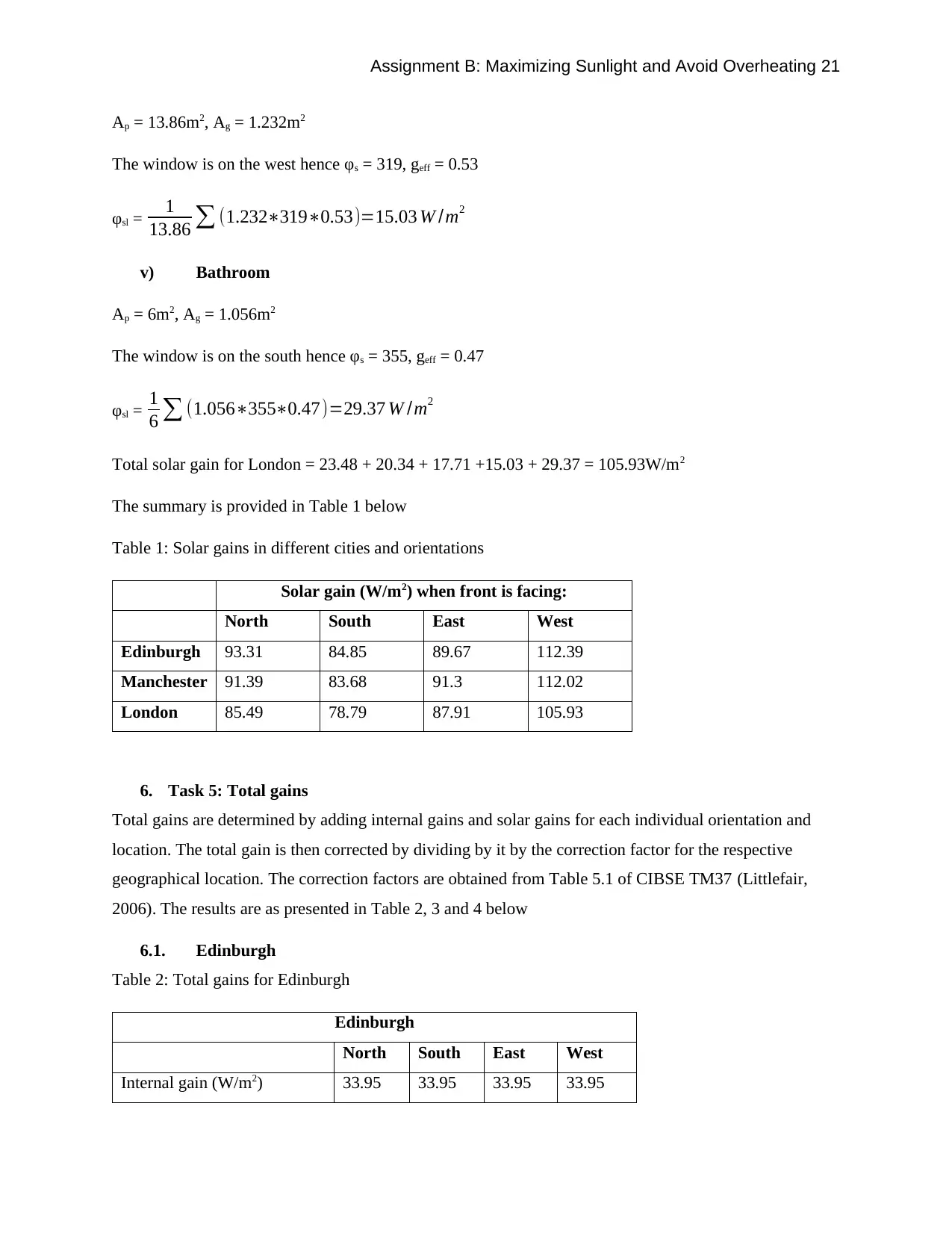
Assignment B: Maximizing Sunlight and Avoid Overheating 21
Ap = 13.86m2, Ag = 1.232m2
The window is on the west hence φs = 319, geff = 0.53
φsl = 1
13.86 ∑ (1.232∗319∗0.53)=15.03 W /m2
v) Bathroom
Ap = 6m2, Ag = 1.056m2
The window is on the south hence φs = 355, geff = 0.47
φsl = 1
6 ∑ (1.056∗355∗0.47)=29.37 W /m2
Total solar gain for London = 23.48 + 20.34 + 17.71 +15.03 + 29.37 = 105.93W/m2
The summary is provided in Table 1 below
Table 1: Solar gains in different cities and orientations
Solar gain (W/m2) when front is facing:
North South East West
Edinburgh 93.31 84.85 89.67 112.39
Manchester 91.39 83.68 91.3 112.02
London 85.49 78.79 87.91 105.93
6. Task 5: Total gains
Total gains are determined by adding internal gains and solar gains for each individual orientation and
location. The total gain is then corrected by dividing by it by the correction factor for the respective
geographical location. The correction factors are obtained from Table 5.1 of CIBSE TM37 (Littlefair,
2006). The results are as presented in Table 2, 3 and 4 below
6.1. Edinburgh
Table 2: Total gains for Edinburgh
Edinburgh
North South East West
Internal gain (W/m2) 33.95 33.95 33.95 33.95
Ap = 13.86m2, Ag = 1.232m2
The window is on the west hence φs = 319, geff = 0.53
φsl = 1
13.86 ∑ (1.232∗319∗0.53)=15.03 W /m2
v) Bathroom
Ap = 6m2, Ag = 1.056m2
The window is on the south hence φs = 355, geff = 0.47
φsl = 1
6 ∑ (1.056∗355∗0.47)=29.37 W /m2
Total solar gain for London = 23.48 + 20.34 + 17.71 +15.03 + 29.37 = 105.93W/m2
The summary is provided in Table 1 below
Table 1: Solar gains in different cities and orientations
Solar gain (W/m2) when front is facing:
North South East West
Edinburgh 93.31 84.85 89.67 112.39
Manchester 91.39 83.68 91.3 112.02
London 85.49 78.79 87.91 105.93
6. Task 5: Total gains
Total gains are determined by adding internal gains and solar gains for each individual orientation and
location. The total gain is then corrected by dividing by it by the correction factor for the respective
geographical location. The correction factors are obtained from Table 5.1 of CIBSE TM37 (Littlefair,
2006). The results are as presented in Table 2, 3 and 4 below
6.1. Edinburgh
Table 2: Total gains for Edinburgh
Edinburgh
North South East West
Internal gain (W/m2) 33.95 33.95 33.95 33.95
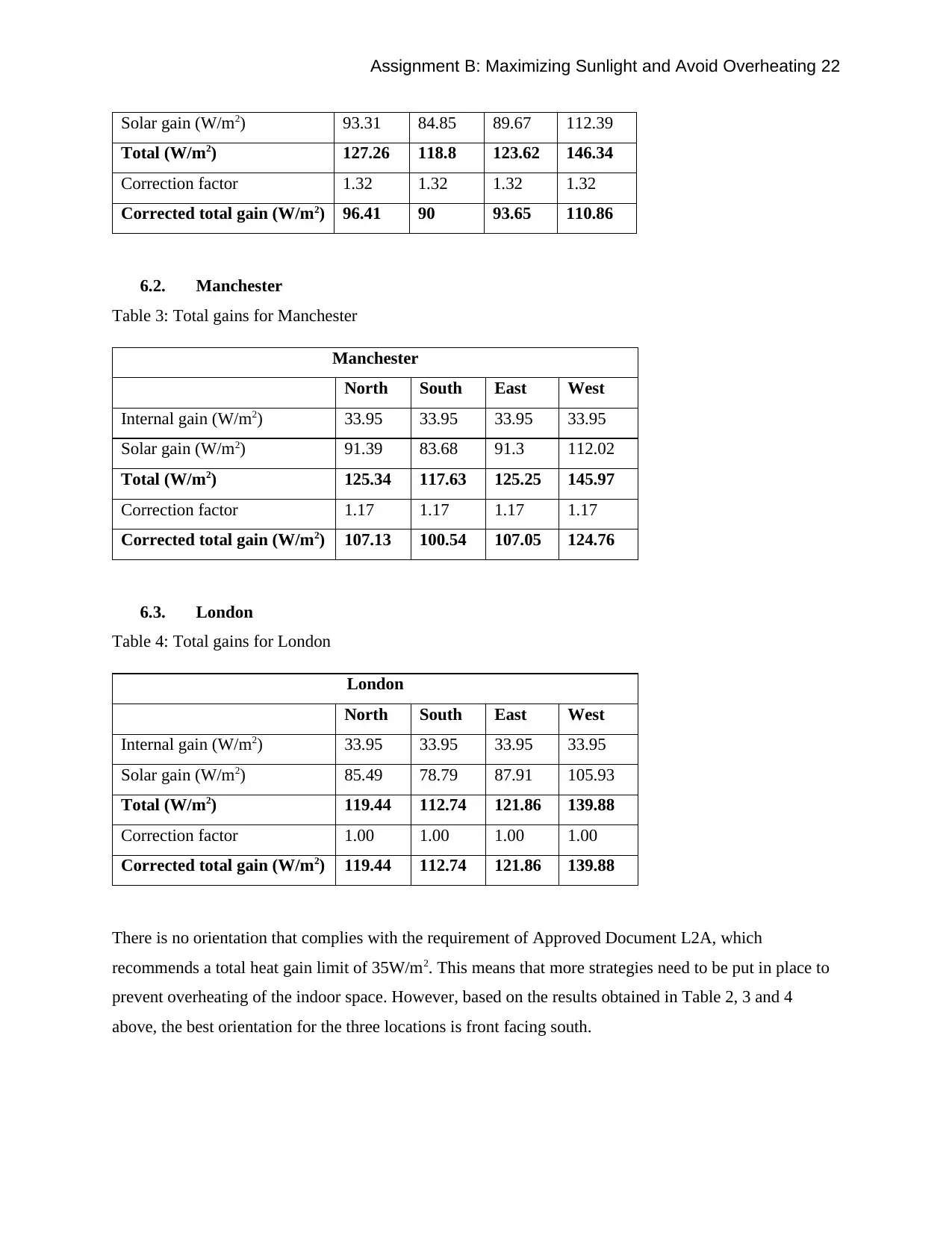
Assignment B: Maximizing Sunlight and Avoid Overheating 22
Solar gain (W/m2) 93.31 84.85 89.67 112.39
Total (W/m2) 127.26 118.8 123.62 146.34
Correction factor 1.32 1.32 1.32 1.32
Corrected total gain (W/m2) 96.41 90 93.65 110.86
6.2. Manchester
Table 3: Total gains for Manchester
Manchester
North South East West
Internal gain (W/m2) 33.95 33.95 33.95 33.95
Solar gain (W/m2) 91.39 83.68 91.3 112.02
Total (W/m2) 125.34 117.63 125.25 145.97
Correction factor 1.17 1.17 1.17 1.17
Corrected total gain (W/m2) 107.13 100.54 107.05 124.76
6.3. London
Table 4: Total gains for London
London
North South East West
Internal gain (W/m2) 33.95 33.95 33.95 33.95
Solar gain (W/m2) 85.49 78.79 87.91 105.93
Total (W/m2) 119.44 112.74 121.86 139.88
Correction factor 1.00 1.00 1.00 1.00
Corrected total gain (W/m2) 119.44 112.74 121.86 139.88
There is no orientation that complies with the requirement of Approved Document L2A, which
recommends a total heat gain limit of 35W/m2. This means that more strategies need to be put in place to
prevent overheating of the indoor space. However, based on the results obtained in Table 2, 3 and 4
above, the best orientation for the three locations is front facing south.
Solar gain (W/m2) 93.31 84.85 89.67 112.39
Total (W/m2) 127.26 118.8 123.62 146.34
Correction factor 1.32 1.32 1.32 1.32
Corrected total gain (W/m2) 96.41 90 93.65 110.86
6.2. Manchester
Table 3: Total gains for Manchester
Manchester
North South East West
Internal gain (W/m2) 33.95 33.95 33.95 33.95
Solar gain (W/m2) 91.39 83.68 91.3 112.02
Total (W/m2) 125.34 117.63 125.25 145.97
Correction factor 1.17 1.17 1.17 1.17
Corrected total gain (W/m2) 107.13 100.54 107.05 124.76
6.3. London
Table 4: Total gains for London
London
North South East West
Internal gain (W/m2) 33.95 33.95 33.95 33.95
Solar gain (W/m2) 85.49 78.79 87.91 105.93
Total (W/m2) 119.44 112.74 121.86 139.88
Correction factor 1.00 1.00 1.00 1.00
Corrected total gain (W/m2) 119.44 112.74 121.86 139.88
There is no orientation that complies with the requirement of Approved Document L2A, which
recommends a total heat gain limit of 35W/m2. This means that more strategies need to be put in place to
prevent overheating of the indoor space. However, based on the results obtained in Table 2, 3 and 4
above, the best orientation for the three locations is front facing south.
Secure Best Marks with AI Grader
Need help grading? Try our AI Grader for instant feedback on your assignments.
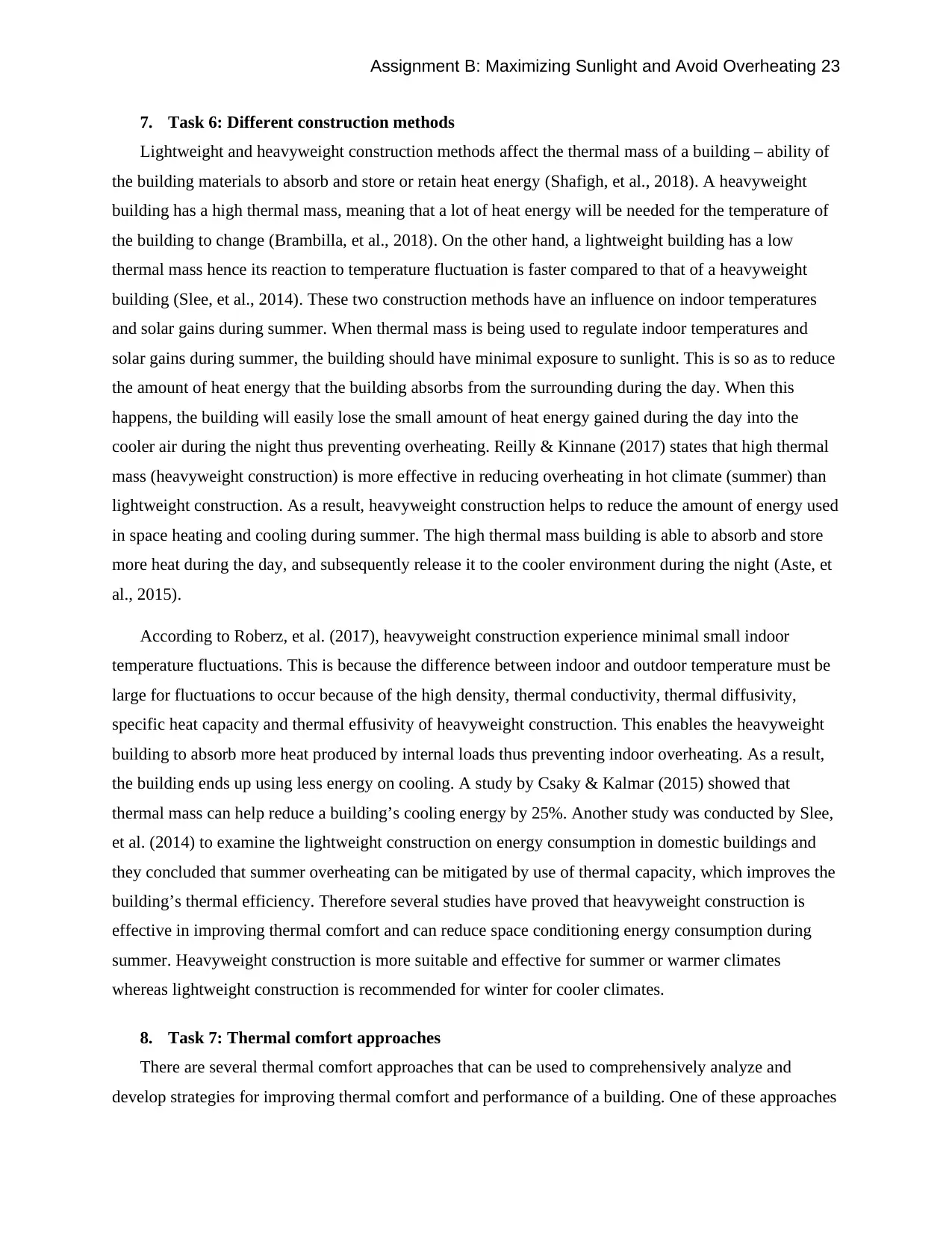
Assignment B: Maximizing Sunlight and Avoid Overheating 23
7. Task 6: Different construction methods
Lightweight and heavyweight construction methods affect the thermal mass of a building – ability of
the building materials to absorb and store or retain heat energy (Shafigh, et al., 2018). A heavyweight
building has a high thermal mass, meaning that a lot of heat energy will be needed for the temperature of
the building to change (Brambilla, et al., 2018). On the other hand, a lightweight building has a low
thermal mass hence its reaction to temperature fluctuation is faster compared to that of a heavyweight
building (Slee, et al., 2014). These two construction methods have an influence on indoor temperatures
and solar gains during summer. When thermal mass is being used to regulate indoor temperatures and
solar gains during summer, the building should have minimal exposure to sunlight. This is so as to reduce
the amount of heat energy that the building absorbs from the surrounding during the day. When this
happens, the building will easily lose the small amount of heat energy gained during the day into the
cooler air during the night thus preventing overheating. Reilly & Kinnane (2017) states that high thermal
mass (heavyweight construction) is more effective in reducing overheating in hot climate (summer) than
lightweight construction. As a result, heavyweight construction helps to reduce the amount of energy used
in space heating and cooling during summer. The high thermal mass building is able to absorb and store
more heat during the day, and subsequently release it to the cooler environment during the night (Aste, et
al., 2015).
According to Roberz, et al. (2017), heavyweight construction experience minimal small indoor
temperature fluctuations. This is because the difference between indoor and outdoor temperature must be
large for fluctuations to occur because of the high density, thermal conductivity, thermal diffusivity,
specific heat capacity and thermal effusivity of heavyweight construction. This enables the heavyweight
building to absorb more heat produced by internal loads thus preventing indoor overheating. As a result,
the building ends up using less energy on cooling. A study by Csaky & Kalmar (2015) showed that
thermal mass can help reduce a building’s cooling energy by 25%. Another study was conducted by Slee,
et al. (2014) to examine the lightweight construction on energy consumption in domestic buildings and
they concluded that summer overheating can be mitigated by use of thermal capacity, which improves the
building’s thermal efficiency. Therefore several studies have proved that heavyweight construction is
effective in improving thermal comfort and can reduce space conditioning energy consumption during
summer. Heavyweight construction is more suitable and effective for summer or warmer climates
whereas lightweight construction is recommended for winter for cooler climates.
8. Task 7: Thermal comfort approaches
There are several thermal comfort approaches that can be used to comprehensively analyze and
develop strategies for improving thermal comfort and performance of a building. One of these approaches
7. Task 6: Different construction methods
Lightweight and heavyweight construction methods affect the thermal mass of a building – ability of
the building materials to absorb and store or retain heat energy (Shafigh, et al., 2018). A heavyweight
building has a high thermal mass, meaning that a lot of heat energy will be needed for the temperature of
the building to change (Brambilla, et al., 2018). On the other hand, a lightweight building has a low
thermal mass hence its reaction to temperature fluctuation is faster compared to that of a heavyweight
building (Slee, et al., 2014). These two construction methods have an influence on indoor temperatures
and solar gains during summer. When thermal mass is being used to regulate indoor temperatures and
solar gains during summer, the building should have minimal exposure to sunlight. This is so as to reduce
the amount of heat energy that the building absorbs from the surrounding during the day. When this
happens, the building will easily lose the small amount of heat energy gained during the day into the
cooler air during the night thus preventing overheating. Reilly & Kinnane (2017) states that high thermal
mass (heavyweight construction) is more effective in reducing overheating in hot climate (summer) than
lightweight construction. As a result, heavyweight construction helps to reduce the amount of energy used
in space heating and cooling during summer. The high thermal mass building is able to absorb and store
more heat during the day, and subsequently release it to the cooler environment during the night (Aste, et
al., 2015).
According to Roberz, et al. (2017), heavyweight construction experience minimal small indoor
temperature fluctuations. This is because the difference between indoor and outdoor temperature must be
large for fluctuations to occur because of the high density, thermal conductivity, thermal diffusivity,
specific heat capacity and thermal effusivity of heavyweight construction. This enables the heavyweight
building to absorb more heat produced by internal loads thus preventing indoor overheating. As a result,
the building ends up using less energy on cooling. A study by Csaky & Kalmar (2015) showed that
thermal mass can help reduce a building’s cooling energy by 25%. Another study was conducted by Slee,
et al. (2014) to examine the lightweight construction on energy consumption in domestic buildings and
they concluded that summer overheating can be mitigated by use of thermal capacity, which improves the
building’s thermal efficiency. Therefore several studies have proved that heavyweight construction is
effective in improving thermal comfort and can reduce space conditioning energy consumption during
summer. Heavyweight construction is more suitable and effective for summer or warmer climates
whereas lightweight construction is recommended for winter for cooler climates.
8. Task 7: Thermal comfort approaches
There are several thermal comfort approaches that can be used to comprehensively analyze and
develop strategies for improving thermal comfort and performance of a building. One of these approaches
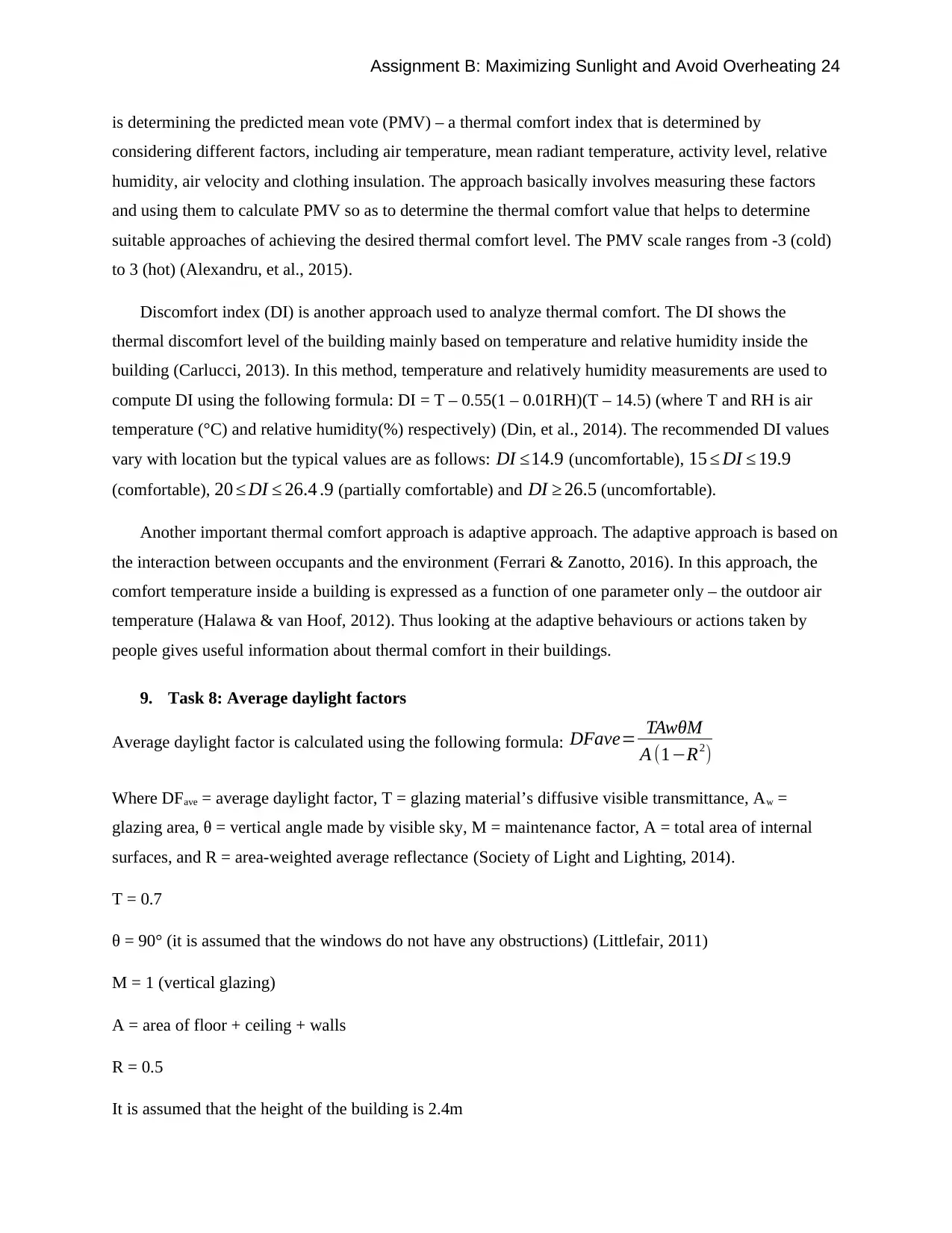
Assignment B: Maximizing Sunlight and Avoid Overheating 24
is determining the predicted mean vote (PMV) – a thermal comfort index that is determined by
considering different factors, including air temperature, mean radiant temperature, activity level, relative
humidity, air velocity and clothing insulation. The approach basically involves measuring these factors
and using them to calculate PMV so as to determine the thermal comfort value that helps to determine
suitable approaches of achieving the desired thermal comfort level. The PMV scale ranges from -3 (cold)
to 3 (hot) (Alexandru, et al., 2015).
Discomfort index (DI) is another approach used to analyze thermal comfort. The DI shows the
thermal discomfort level of the building mainly based on temperature and relative humidity inside the
building (Carlucci, 2013). In this method, temperature and relatively humidity measurements are used to
compute DI using the following formula: DI = T – 0.55(1 – 0.01RH)(T – 14.5) (where T and RH is air
temperature (°C) and relative humidity(%) respectively) (Din, et al., 2014). The recommended DI values
vary with location but the typical values are as follows: DI ≤14.9 (uncomfortable), 15 ≤ DI ≤ 19.9
(comfortable), 20 ≤ DI ≤ 26.4 .9 (partially comfortable) and DI ≥ 26.5 (uncomfortable).
Another important thermal comfort approach is adaptive approach. The adaptive approach is based on
the interaction between occupants and the environment (Ferrari & Zanotto, 2016). In this approach, the
comfort temperature inside a building is expressed as a function of one parameter only – the outdoor air
temperature (Halawa & van Hoof, 2012). Thus looking at the adaptive behaviours or actions taken by
people gives useful information about thermal comfort in their buildings.
9. Task 8: Average daylight factors
Average daylight factor is calculated using the following formula: DFave= TAwθM
A (1−R2)
Where DFave = average daylight factor, T = glazing material’s diffusive visible transmittance, Aw =
glazing area, θ = vertical angle made by visible sky, M = maintenance factor, A = total area of internal
surfaces, and R = area-weighted average reflectance (Society of Light and Lighting, 2014).
T = 0.7
θ = 90° (it is assumed that the windows do not have any obstructions) (Littlefair, 2011)
M = 1 (vertical glazing)
A = area of floor + ceiling + walls
R = 0.5
It is assumed that the height of the building is 2.4m
is determining the predicted mean vote (PMV) – a thermal comfort index that is determined by
considering different factors, including air temperature, mean radiant temperature, activity level, relative
humidity, air velocity and clothing insulation. The approach basically involves measuring these factors
and using them to calculate PMV so as to determine the thermal comfort value that helps to determine
suitable approaches of achieving the desired thermal comfort level. The PMV scale ranges from -3 (cold)
to 3 (hot) (Alexandru, et al., 2015).
Discomfort index (DI) is another approach used to analyze thermal comfort. The DI shows the
thermal discomfort level of the building mainly based on temperature and relative humidity inside the
building (Carlucci, 2013). In this method, temperature and relatively humidity measurements are used to
compute DI using the following formula: DI = T – 0.55(1 – 0.01RH)(T – 14.5) (where T and RH is air
temperature (°C) and relative humidity(%) respectively) (Din, et al., 2014). The recommended DI values
vary with location but the typical values are as follows: DI ≤14.9 (uncomfortable), 15 ≤ DI ≤ 19.9
(comfortable), 20 ≤ DI ≤ 26.4 .9 (partially comfortable) and DI ≥ 26.5 (uncomfortable).
Another important thermal comfort approach is adaptive approach. The adaptive approach is based on
the interaction between occupants and the environment (Ferrari & Zanotto, 2016). In this approach, the
comfort temperature inside a building is expressed as a function of one parameter only – the outdoor air
temperature (Halawa & van Hoof, 2012). Thus looking at the adaptive behaviours or actions taken by
people gives useful information about thermal comfort in their buildings.
9. Task 8: Average daylight factors
Average daylight factor is calculated using the following formula: DFave= TAwθM
A (1−R2)
Where DFave = average daylight factor, T = glazing material’s diffusive visible transmittance, Aw =
glazing area, θ = vertical angle made by visible sky, M = maintenance factor, A = total area of internal
surfaces, and R = area-weighted average reflectance (Society of Light and Lighting, 2014).
T = 0.7
θ = 90° (it is assumed that the windows do not have any obstructions) (Littlefair, 2011)
M = 1 (vertical glazing)
A = area of floor + ceiling + walls
R = 0.5
It is assumed that the height of the building is 2.4m
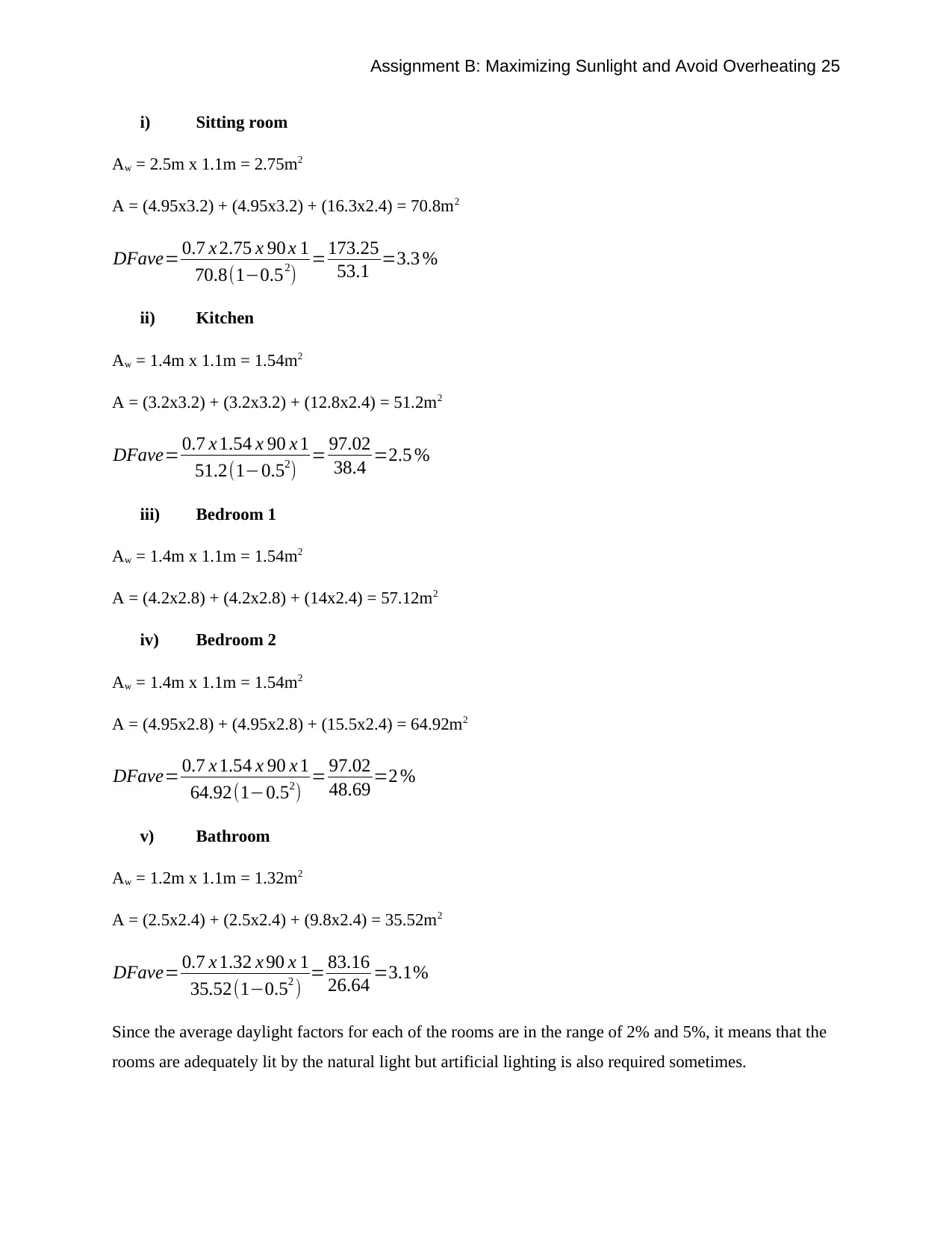
Assignment B: Maximizing Sunlight and Avoid Overheating 25
i) Sitting room
Aw = 2.5m x 1.1m = 2.75m2
A = (4.95x3.2) + (4.95x3.2) + (16.3x2.4) = 70.8m2
DFave= 0.7 x 2.75 x 90 x 1
70.8(1−0.52) =173.25
53.1 =3.3 %
ii) Kitchen
Aw = 1.4m x 1.1m = 1.54m2
A = (3.2x3.2) + (3.2x3.2) + (12.8x2.4) = 51.2m2
DFave= 0.7 x 1.54 x 90 x 1
51.2(1−0.52) = 97.02
38.4 =2.5 %
iii) Bedroom 1
Aw = 1.4m x 1.1m = 1.54m2
A = (4.2x2.8) + (4.2x2.8) + (14x2.4) = 57.12m2
iv) Bedroom 2
Aw = 1.4m x 1.1m = 1.54m2
A = (4.95x2.8) + (4.95x2.8) + (15.5x2.4) = 64.92m2
DFave= 0.7 x 1.54 x 90 x 1
64.92(1−0.52) = 97.02
48.69 =2 %
v) Bathroom
Aw = 1.2m x 1.1m = 1.32m2
A = (2.5x2.4) + (2.5x2.4) + (9.8x2.4) = 35.52m2
DFave= 0.7 x 1.32 x 90 x 1
35.52(1−0.52 ) = 83.16
26.64 =3.1%
Since the average daylight factors for each of the rooms are in the range of 2% and 5%, it means that the
rooms are adequately lit by the natural light but artificial lighting is also required sometimes.
i) Sitting room
Aw = 2.5m x 1.1m = 2.75m2
A = (4.95x3.2) + (4.95x3.2) + (16.3x2.4) = 70.8m2
DFave= 0.7 x 2.75 x 90 x 1
70.8(1−0.52) =173.25
53.1 =3.3 %
ii) Kitchen
Aw = 1.4m x 1.1m = 1.54m2
A = (3.2x3.2) + (3.2x3.2) + (12.8x2.4) = 51.2m2
DFave= 0.7 x 1.54 x 90 x 1
51.2(1−0.52) = 97.02
38.4 =2.5 %
iii) Bedroom 1
Aw = 1.4m x 1.1m = 1.54m2
A = (4.2x2.8) + (4.2x2.8) + (14x2.4) = 57.12m2
iv) Bedroom 2
Aw = 1.4m x 1.1m = 1.54m2
A = (4.95x2.8) + (4.95x2.8) + (15.5x2.4) = 64.92m2
DFave= 0.7 x 1.54 x 90 x 1
64.92(1−0.52) = 97.02
48.69 =2 %
v) Bathroom
Aw = 1.2m x 1.1m = 1.32m2
A = (2.5x2.4) + (2.5x2.4) + (9.8x2.4) = 35.52m2
DFave= 0.7 x 1.32 x 90 x 1
35.52(1−0.52 ) = 83.16
26.64 =3.1%
Since the average daylight factors for each of the rooms are in the range of 2% and 5%, it means that the
rooms are adequately lit by the natural light but artificial lighting is also required sometimes.
Paraphrase This Document
Need a fresh take? Get an instant paraphrase of this document with our AI Paraphraser
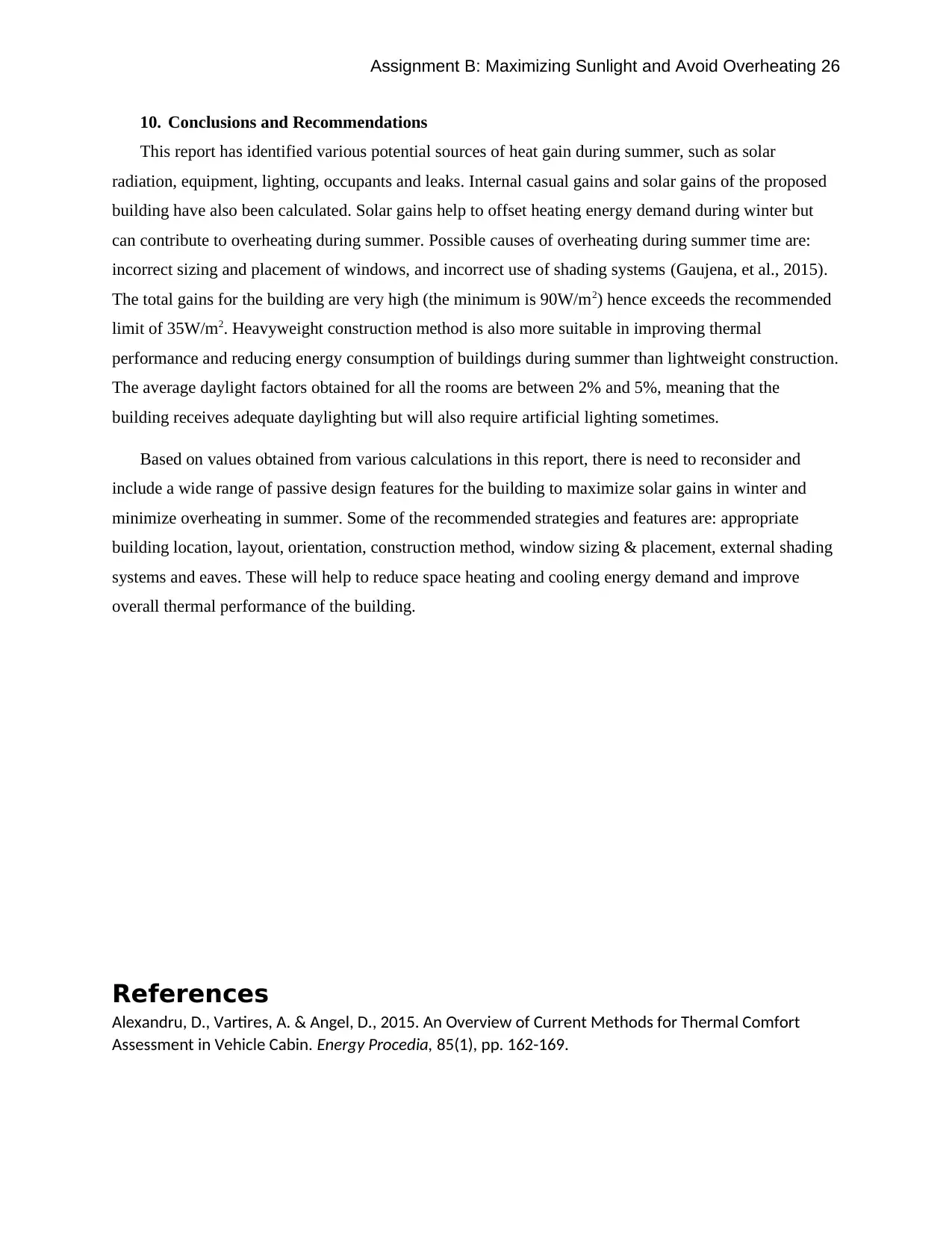
Assignment B: Maximizing Sunlight and Avoid Overheating 26
10. Conclusions and Recommendations
This report has identified various potential sources of heat gain during summer, such as solar
radiation, equipment, lighting, occupants and leaks. Internal casual gains and solar gains of the proposed
building have also been calculated. Solar gains help to offset heating energy demand during winter but
can contribute to overheating during summer. Possible causes of overheating during summer time are:
incorrect sizing and placement of windows, and incorrect use of shading systems (Gaujena, et al., 2015).
The total gains for the building are very high (the minimum is 90W/m2) hence exceeds the recommended
limit of 35W/m2. Heavyweight construction method is also more suitable in improving thermal
performance and reducing energy consumption of buildings during summer than lightweight construction.
The average daylight factors obtained for all the rooms are between 2% and 5%, meaning that the
building receives adequate daylighting but will also require artificial lighting sometimes.
Based on values obtained from various calculations in this report, there is need to reconsider and
include a wide range of passive design features for the building to maximize solar gains in winter and
minimize overheating in summer. Some of the recommended strategies and features are: appropriate
building location, layout, orientation, construction method, window sizing & placement, external shading
systems and eaves. These will help to reduce space heating and cooling energy demand and improve
overall thermal performance of the building.
References
Alexandru, D., Vartires, A. & Angel, D., 2015. An Overview of Current Methods for Thermal Comfort
Assessment in Vehicle Cabin. Energy Procedia, 85(1), pp. 162-169.
10. Conclusions and Recommendations
This report has identified various potential sources of heat gain during summer, such as solar
radiation, equipment, lighting, occupants and leaks. Internal casual gains and solar gains of the proposed
building have also been calculated. Solar gains help to offset heating energy demand during winter but
can contribute to overheating during summer. Possible causes of overheating during summer time are:
incorrect sizing and placement of windows, and incorrect use of shading systems (Gaujena, et al., 2015).
The total gains for the building are very high (the minimum is 90W/m2) hence exceeds the recommended
limit of 35W/m2. Heavyweight construction method is also more suitable in improving thermal
performance and reducing energy consumption of buildings during summer than lightweight construction.
The average daylight factors obtained for all the rooms are between 2% and 5%, meaning that the
building receives adequate daylighting but will also require artificial lighting sometimes.
Based on values obtained from various calculations in this report, there is need to reconsider and
include a wide range of passive design features for the building to maximize solar gains in winter and
minimize overheating in summer. Some of the recommended strategies and features are: appropriate
building location, layout, orientation, construction method, window sizing & placement, external shading
systems and eaves. These will help to reduce space heating and cooling energy demand and improve
overall thermal performance of the building.
References
Alexandru, D., Vartires, A. & Angel, D., 2015. An Overview of Current Methods for Thermal Comfort
Assessment in Vehicle Cabin. Energy Procedia, 85(1), pp. 162-169.
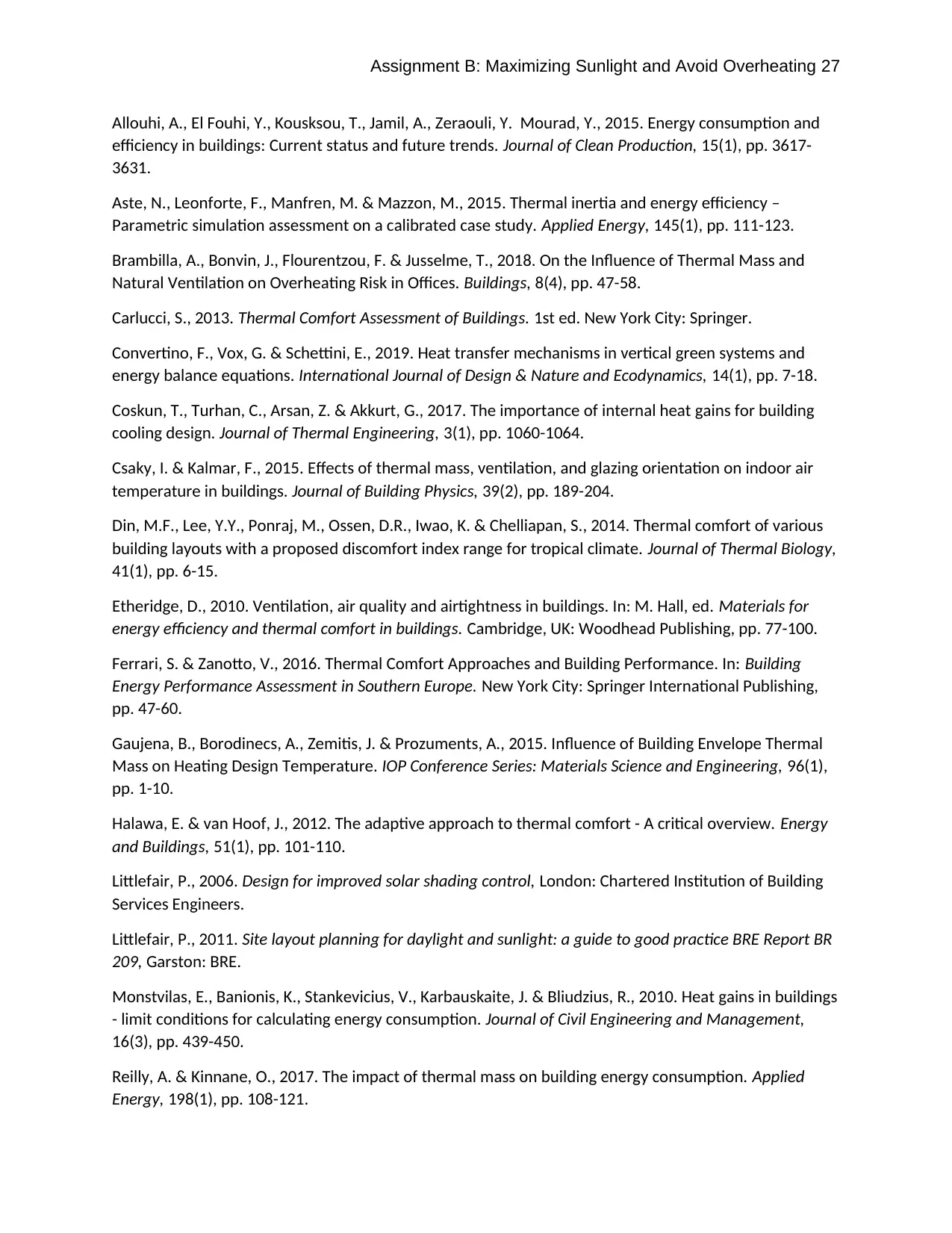
Assignment B: Maximizing Sunlight and Avoid Overheating 27
Allouhi, A., El Fouhi, Y., Kousksou, T., Jamil, A., Zeraouli, Y. Mourad, Y., 2015. Energy consumption and
efficiency in buildings: Current status and future trends. Journal of Clean Production, 15(1), pp. 3617-
3631.
Aste, N., Leonforte, F., Manfren, M. & Mazzon, M., 2015. Thermal inertia and energy efficiency –
Parametric simulation assessment on a calibrated case study. Applied Energy, 145(1), pp. 111-123.
Brambilla, A., Bonvin, J., Flourentzou, F. & Jusselme, T., 2018. On the Influence of Thermal Mass and
Natural Ventilation on Overheating Risk in Offices. Buildings, 8(4), pp. 47-58.
Carlucci, S., 2013. Thermal Comfort Assessment of Buildings. 1st ed. New York City: Springer.
Convertino, F., Vox, G. & Schettini, E., 2019. Heat transfer mechanisms in vertical green systems and
energy balance equations. International Journal of Design & Nature and Ecodynamics, 14(1), pp. 7-18.
Coskun, T., Turhan, C., Arsan, Z. & Akkurt, G., 2017. The importance of internal heat gains for building
cooling design. Journal of Thermal Engineering, 3(1), pp. 1060-1064.
Csaky, I. & Kalmar, F., 2015. Effects of thermal mass, ventilation, and glazing orientation on indoor air
temperature in buildings. Journal of Building Physics, 39(2), pp. 189-204.
Din, M.F., Lee, Y.Y., Ponraj, M., Ossen, D.R., Iwao, K. & Chelliapan, S., 2014. Thermal comfort of various
building layouts with a proposed discomfort index range for tropical climate. Journal of Thermal Biology,
41(1), pp. 6-15.
Etheridge, D., 2010. Ventilation, air quality and airtightness in buildings. In: M. Hall, ed. Materials for
energy efficiency and thermal comfort in buildings. Cambridge, UK: Woodhead Publishing, pp. 77-100.
Ferrari, S. & Zanotto, V., 2016. Thermal Comfort Approaches and Building Performance. In: Building
Energy Performance Assessment in Southern Europe. New York City: Springer International Publishing,
pp. 47-60.
Gaujena, B., Borodinecs, A., Zemitis, J. & Prozuments, A., 2015. Influence of Building Envelope Thermal
Mass on Heating Design Temperature. IOP Conference Series: Materials Science and Engineering, 96(1),
pp. 1-10.
Halawa, E. & van Hoof, J., 2012. The adaptive approach to thermal comfort - A critical overview. Energy
and Buildings, 51(1), pp. 101-110.
Littlefair, P., 2006. Design for improved solar shading control, London: Chartered Institution of Building
Services Engineers.
Littlefair, P., 2011. Site layout planning for daylight and sunlight: a guide to good practice BRE Report BR
209, Garston: BRE.
Monstvilas, E., Banionis, K., Stankevicius, V., Karbauskaite, J. & Bliudzius, R., 2010. Heat gains in buildings
- limit conditions for calculating energy consumption. Journal of Civil Engineering and Management,
16(3), pp. 439-450.
Reilly, A. & Kinnane, O., 2017. The impact of thermal mass on building energy consumption. Applied
Energy, 198(1), pp. 108-121.
Allouhi, A., El Fouhi, Y., Kousksou, T., Jamil, A., Zeraouli, Y. Mourad, Y., 2015. Energy consumption and
efficiency in buildings: Current status and future trends. Journal of Clean Production, 15(1), pp. 3617-
3631.
Aste, N., Leonforte, F., Manfren, M. & Mazzon, M., 2015. Thermal inertia and energy efficiency –
Parametric simulation assessment on a calibrated case study. Applied Energy, 145(1), pp. 111-123.
Brambilla, A., Bonvin, J., Flourentzou, F. & Jusselme, T., 2018. On the Influence of Thermal Mass and
Natural Ventilation on Overheating Risk in Offices. Buildings, 8(4), pp. 47-58.
Carlucci, S., 2013. Thermal Comfort Assessment of Buildings. 1st ed. New York City: Springer.
Convertino, F., Vox, G. & Schettini, E., 2019. Heat transfer mechanisms in vertical green systems and
energy balance equations. International Journal of Design & Nature and Ecodynamics, 14(1), pp. 7-18.
Coskun, T., Turhan, C., Arsan, Z. & Akkurt, G., 2017. The importance of internal heat gains for building
cooling design. Journal of Thermal Engineering, 3(1), pp. 1060-1064.
Csaky, I. & Kalmar, F., 2015. Effects of thermal mass, ventilation, and glazing orientation on indoor air
temperature in buildings. Journal of Building Physics, 39(2), pp. 189-204.
Din, M.F., Lee, Y.Y., Ponraj, M., Ossen, D.R., Iwao, K. & Chelliapan, S., 2014. Thermal comfort of various
building layouts with a proposed discomfort index range for tropical climate. Journal of Thermal Biology,
41(1), pp. 6-15.
Etheridge, D., 2010. Ventilation, air quality and airtightness in buildings. In: M. Hall, ed. Materials for
energy efficiency and thermal comfort in buildings. Cambridge, UK: Woodhead Publishing, pp. 77-100.
Ferrari, S. & Zanotto, V., 2016. Thermal Comfort Approaches and Building Performance. In: Building
Energy Performance Assessment in Southern Europe. New York City: Springer International Publishing,
pp. 47-60.
Gaujena, B., Borodinecs, A., Zemitis, J. & Prozuments, A., 2015. Influence of Building Envelope Thermal
Mass on Heating Design Temperature. IOP Conference Series: Materials Science and Engineering, 96(1),
pp. 1-10.
Halawa, E. & van Hoof, J., 2012. The adaptive approach to thermal comfort - A critical overview. Energy
and Buildings, 51(1), pp. 101-110.
Littlefair, P., 2006. Design for improved solar shading control, London: Chartered Institution of Building
Services Engineers.
Littlefair, P., 2011. Site layout planning for daylight and sunlight: a guide to good practice BRE Report BR
209, Garston: BRE.
Monstvilas, E., Banionis, K., Stankevicius, V., Karbauskaite, J. & Bliudzius, R., 2010. Heat gains in buildings
- limit conditions for calculating energy consumption. Journal of Civil Engineering and Management,
16(3), pp. 439-450.
Reilly, A. & Kinnane, O., 2017. The impact of thermal mass on building energy consumption. Applied
Energy, 198(1), pp. 108-121.
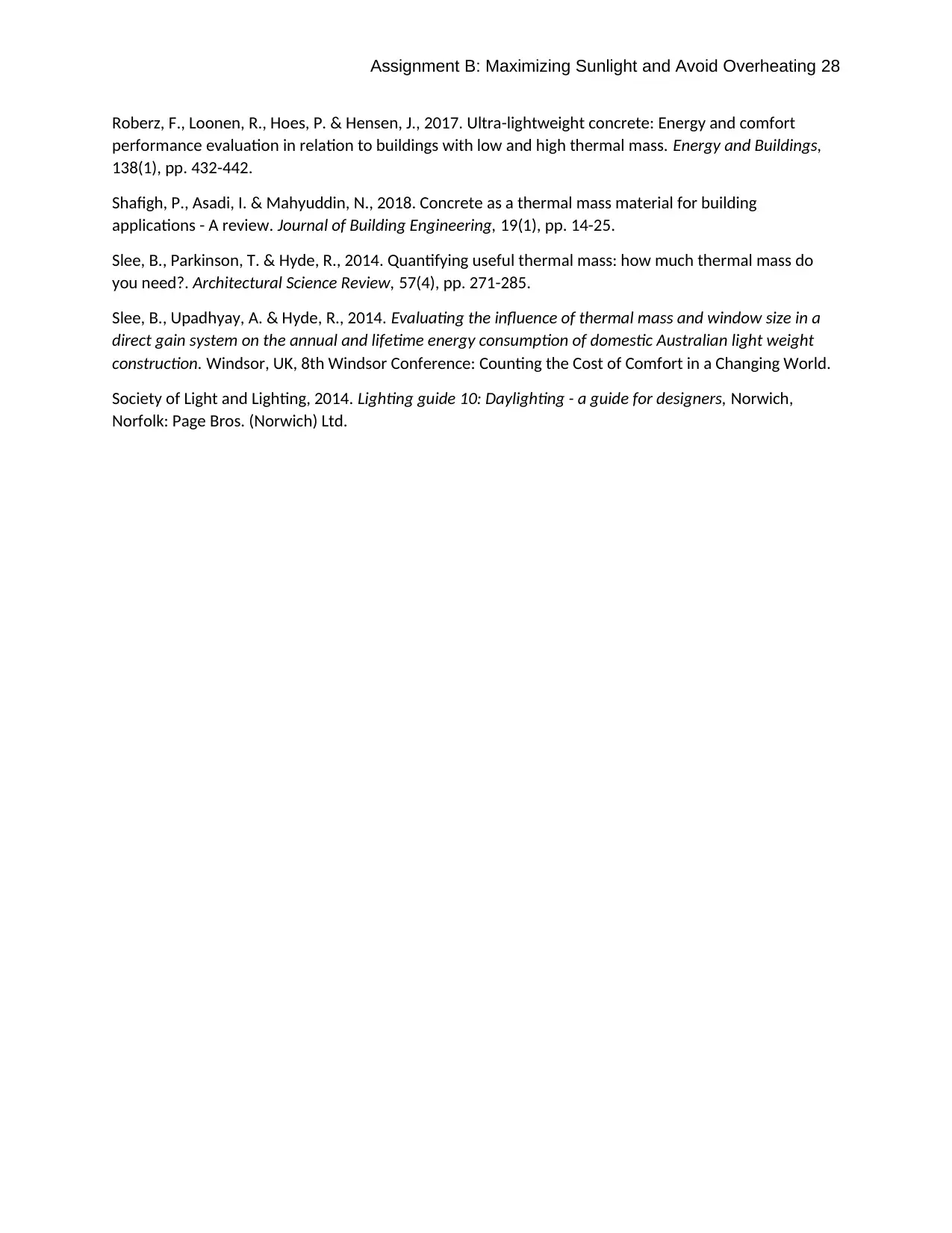
Assignment B: Maximizing Sunlight and Avoid Overheating 28
Roberz, F., Loonen, R., Hoes, P. & Hensen, J., 2017. Ultra-lightweight concrete: Energy and comfort
performance evaluation in relation to buildings with low and high thermal mass. Energy and Buildings,
138(1), pp. 432-442.
Shafigh, P., Asadi, I. & Mahyuddin, N., 2018. Concrete as a thermal mass material for building
applications - A review. Journal of Building Engineering, 19(1), pp. 14-25.
Slee, B., Parkinson, T. & Hyde, R., 2014. Quantifying useful thermal mass: how much thermal mass do
you need?. Architectural Science Review, 57(4), pp. 271-285.
Slee, B., Upadhyay, A. & Hyde, R., 2014. Evaluating the influence of thermal mass and window size in a
direct gain system on the annual and lifetime energy consumption of domestic Australian light weight
construction. Windsor, UK, 8th Windsor Conference: Counting the Cost of Comfort in a Changing World.
Society of Light and Lighting, 2014. Lighting guide 10: Daylighting - a guide for designers, Norwich,
Norfolk: Page Bros. (Norwich) Ltd.
Roberz, F., Loonen, R., Hoes, P. & Hensen, J., 2017. Ultra-lightweight concrete: Energy and comfort
performance evaluation in relation to buildings with low and high thermal mass. Energy and Buildings,
138(1), pp. 432-442.
Shafigh, P., Asadi, I. & Mahyuddin, N., 2018. Concrete as a thermal mass material for building
applications - A review. Journal of Building Engineering, 19(1), pp. 14-25.
Slee, B., Parkinson, T. & Hyde, R., 2014. Quantifying useful thermal mass: how much thermal mass do
you need?. Architectural Science Review, 57(4), pp. 271-285.
Slee, B., Upadhyay, A. & Hyde, R., 2014. Evaluating the influence of thermal mass and window size in a
direct gain system on the annual and lifetime energy consumption of domestic Australian light weight
construction. Windsor, UK, 8th Windsor Conference: Counting the Cost of Comfort in a Changing World.
Society of Light and Lighting, 2014. Lighting guide 10: Daylighting - a guide for designers, Norwich,
Norfolk: Page Bros. (Norwich) Ltd.
1 out of 28
Related Documents
Your All-in-One AI-Powered Toolkit for Academic Success.
+13062052269
info@desklib.com
Available 24*7 on WhatsApp / Email
![[object Object]](/_next/static/media/star-bottom.7253800d.svg)
Unlock your academic potential
© 2024 | Zucol Services PVT LTD | All rights reserved.





